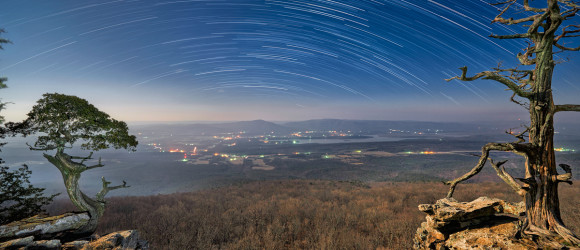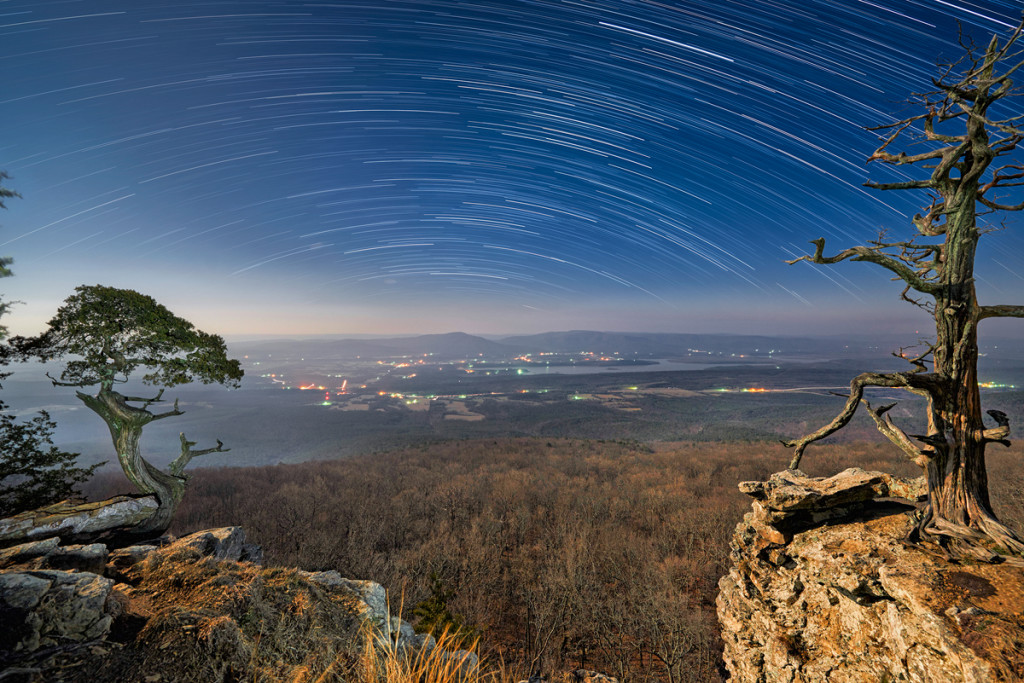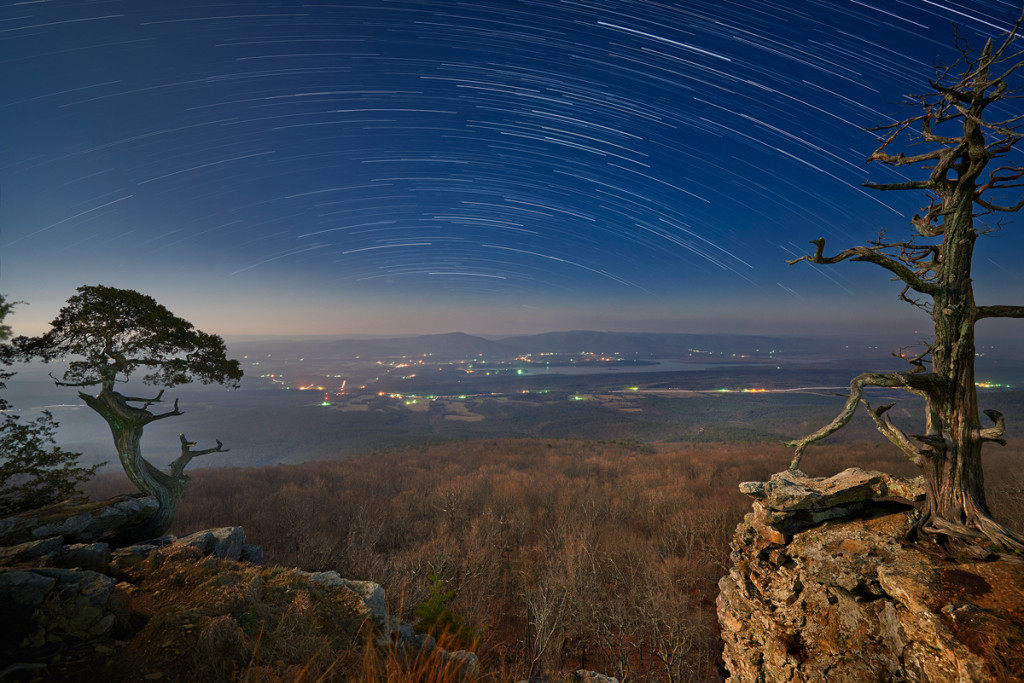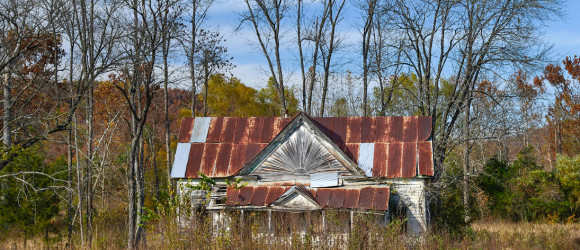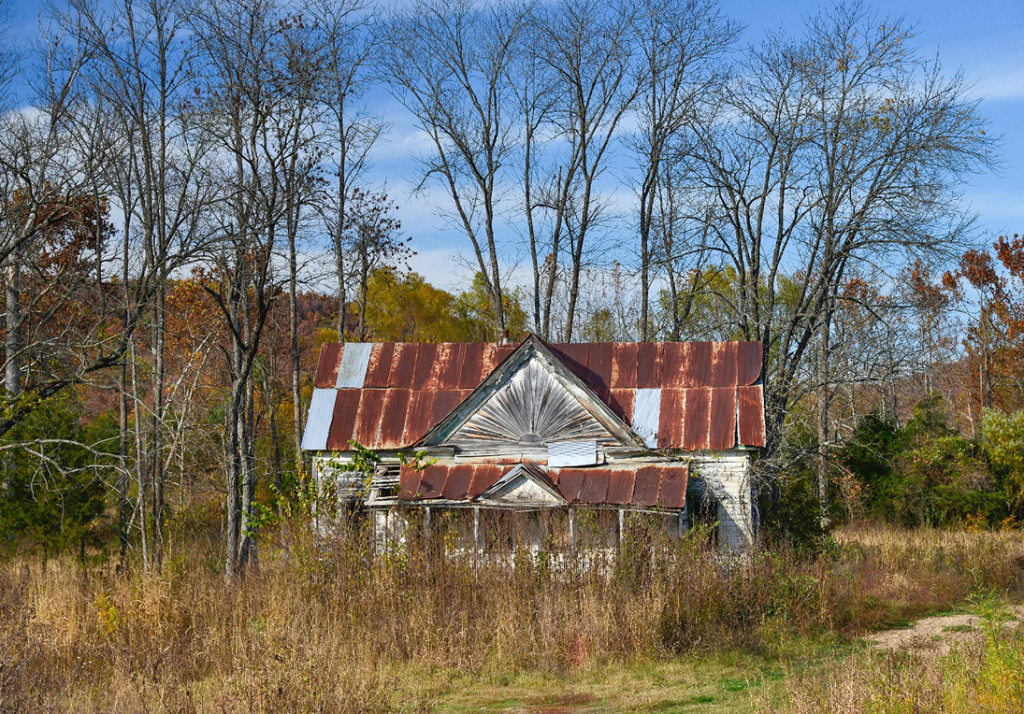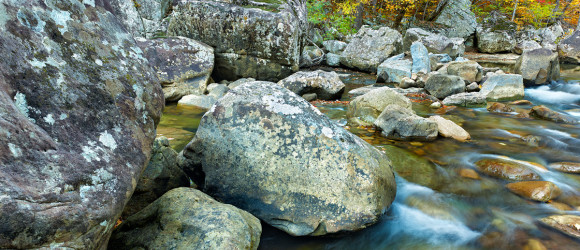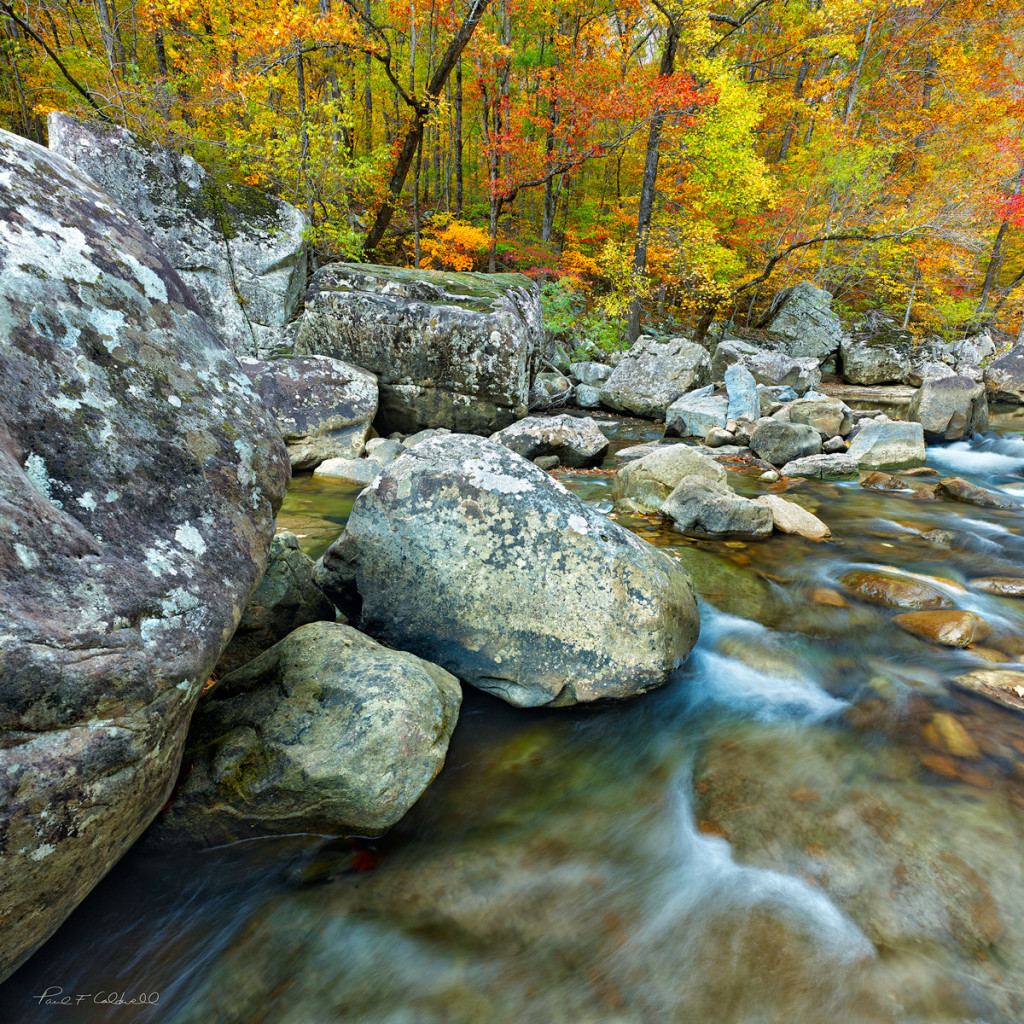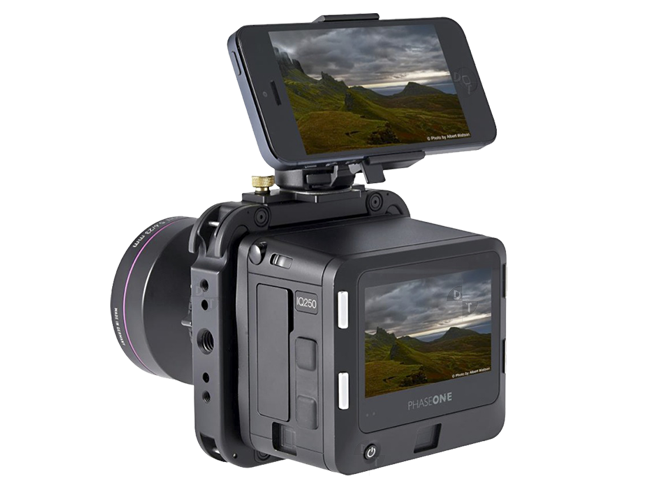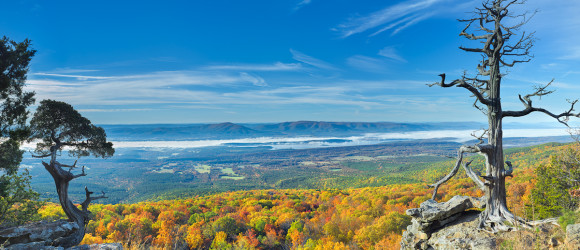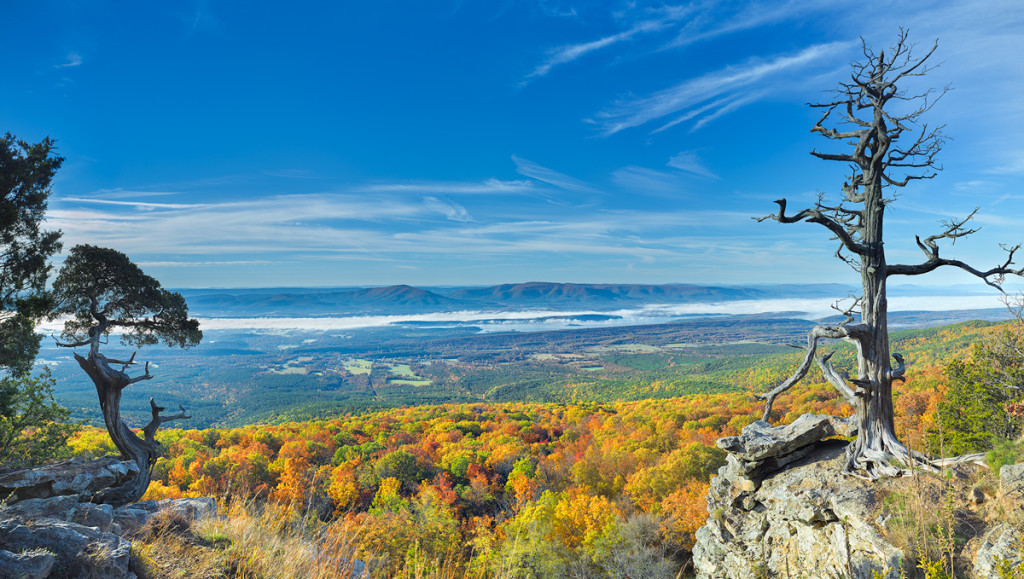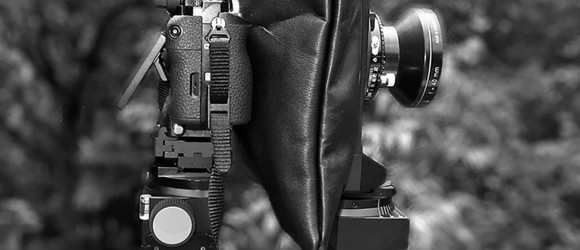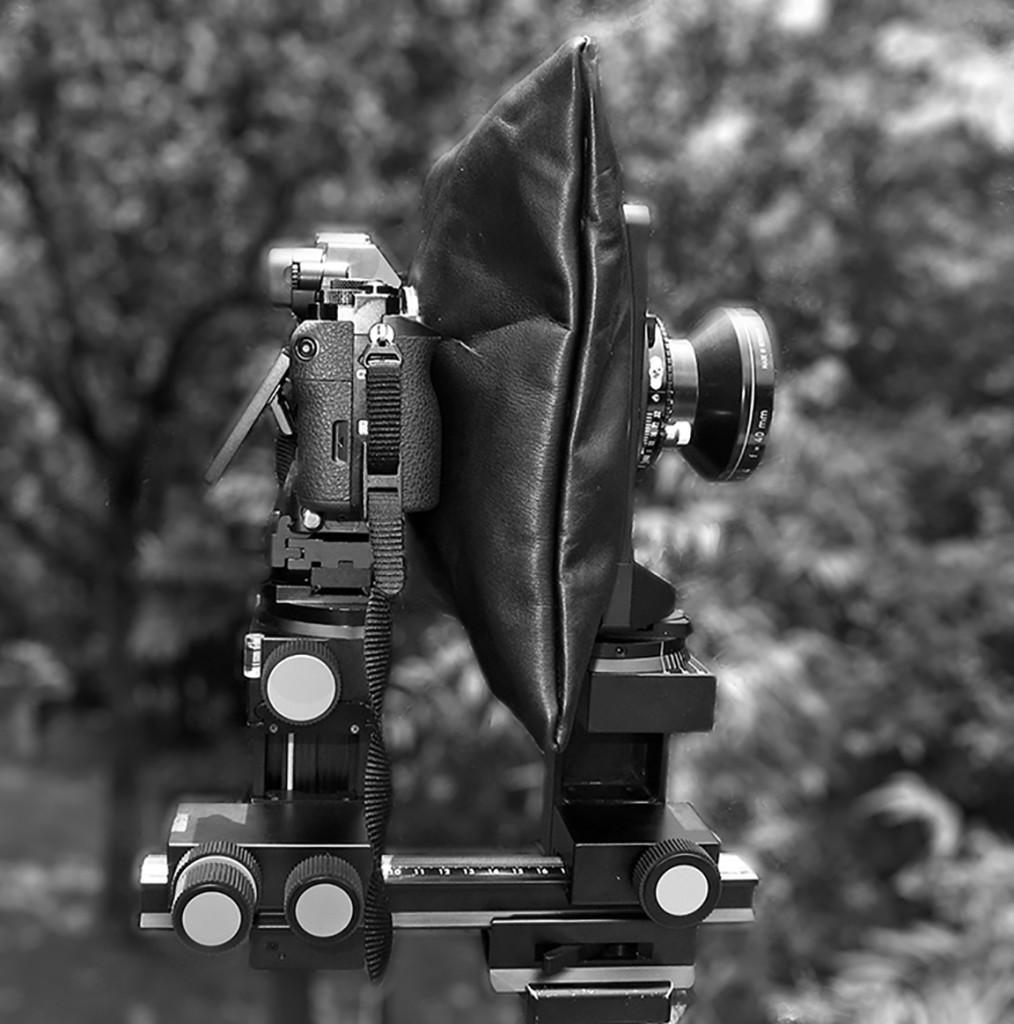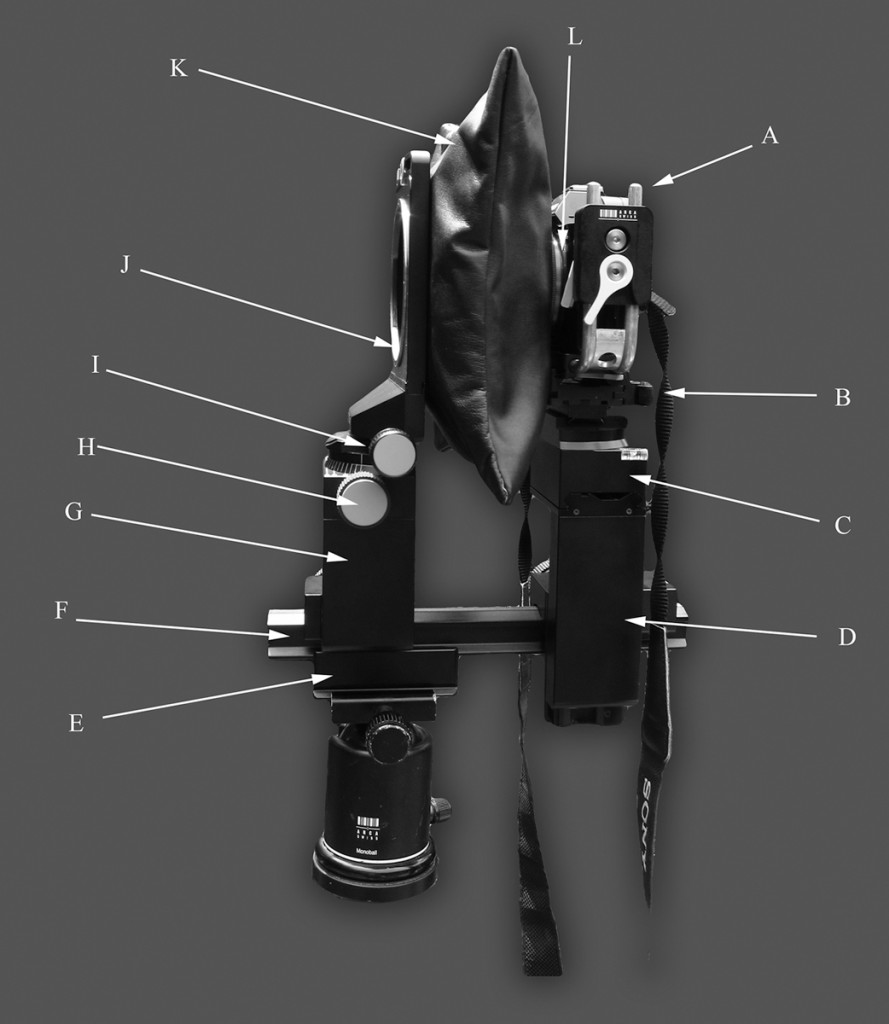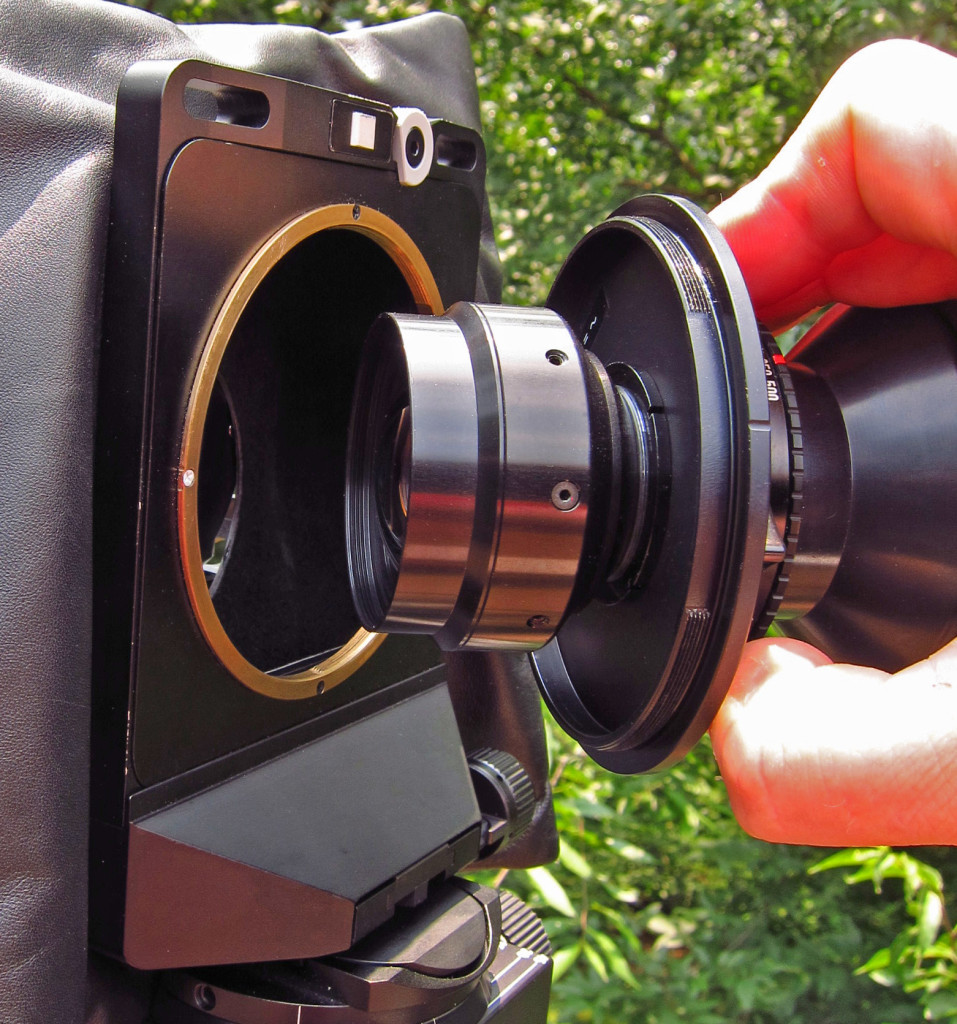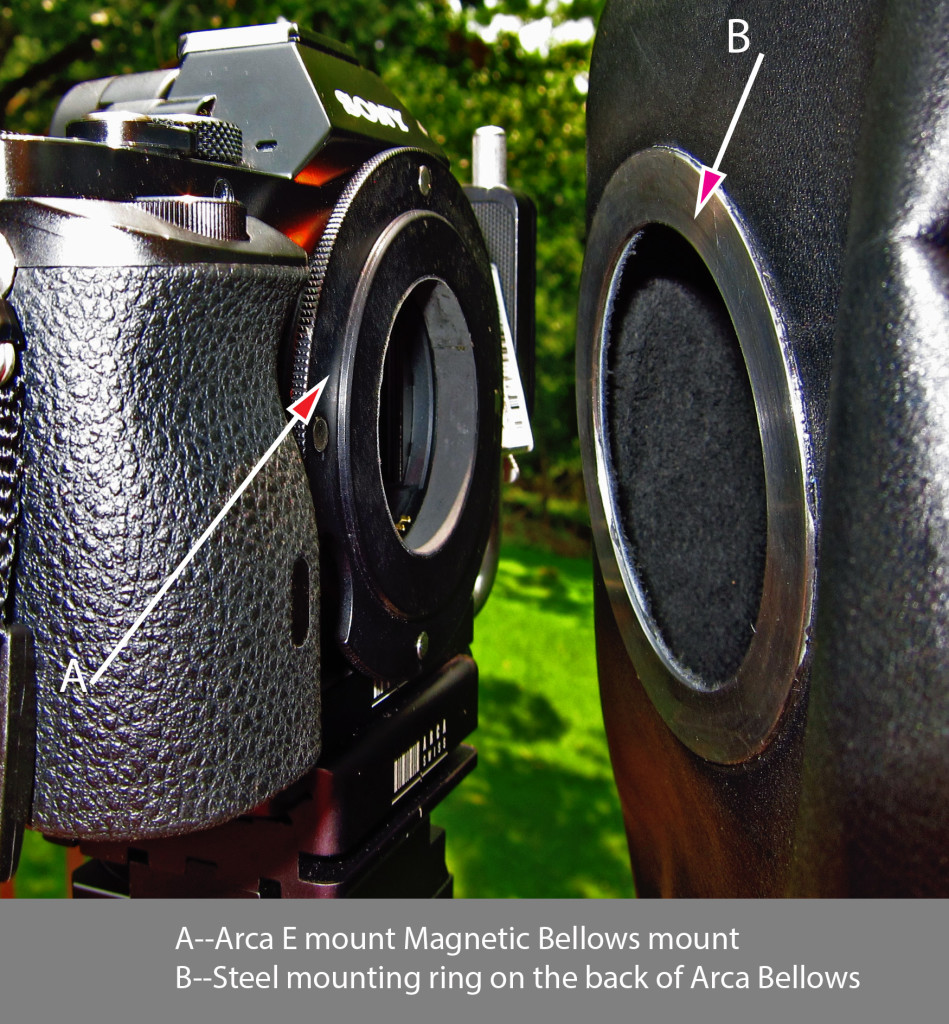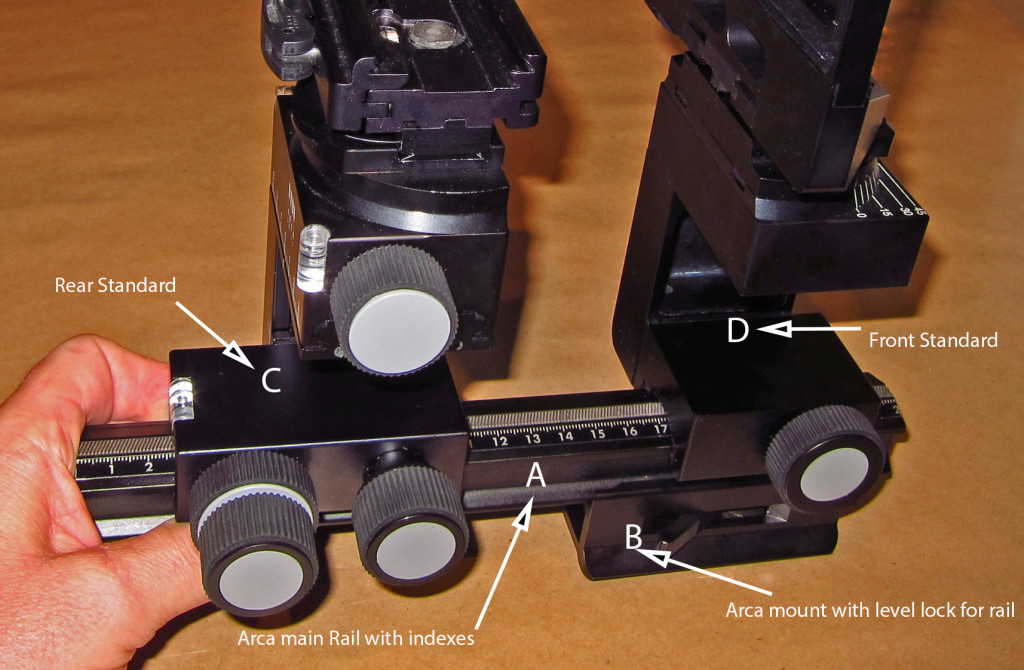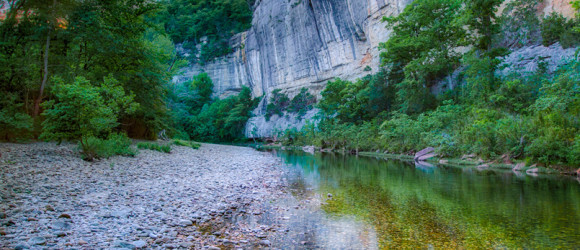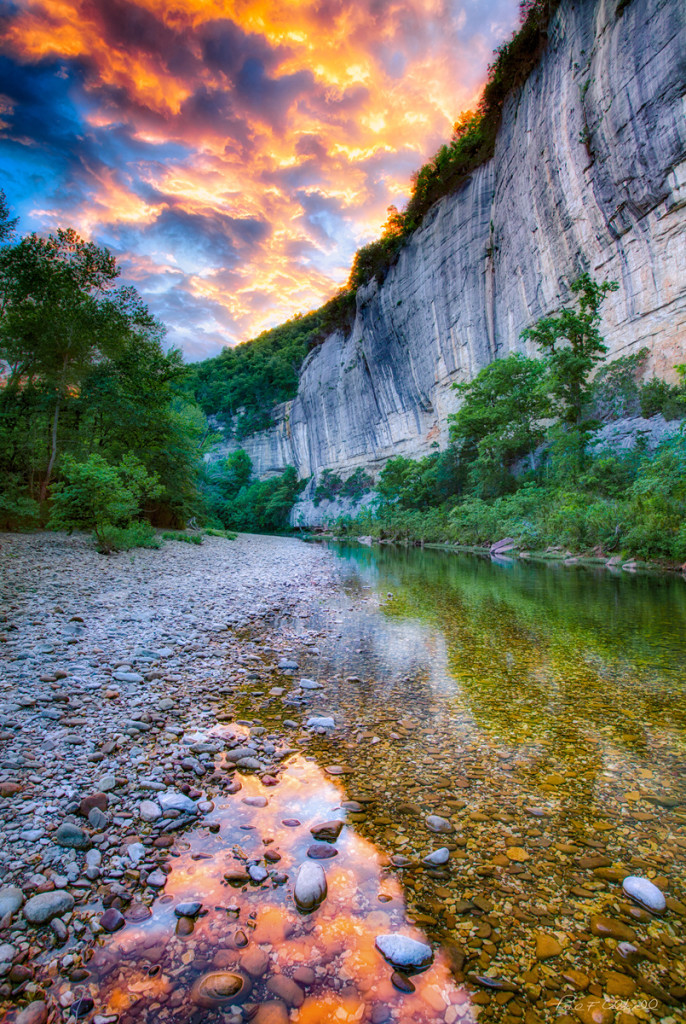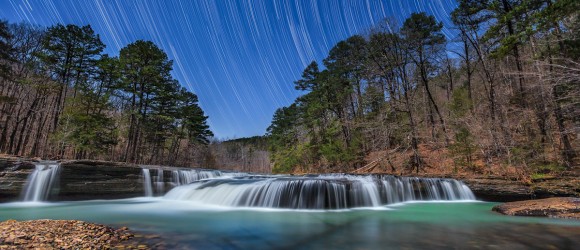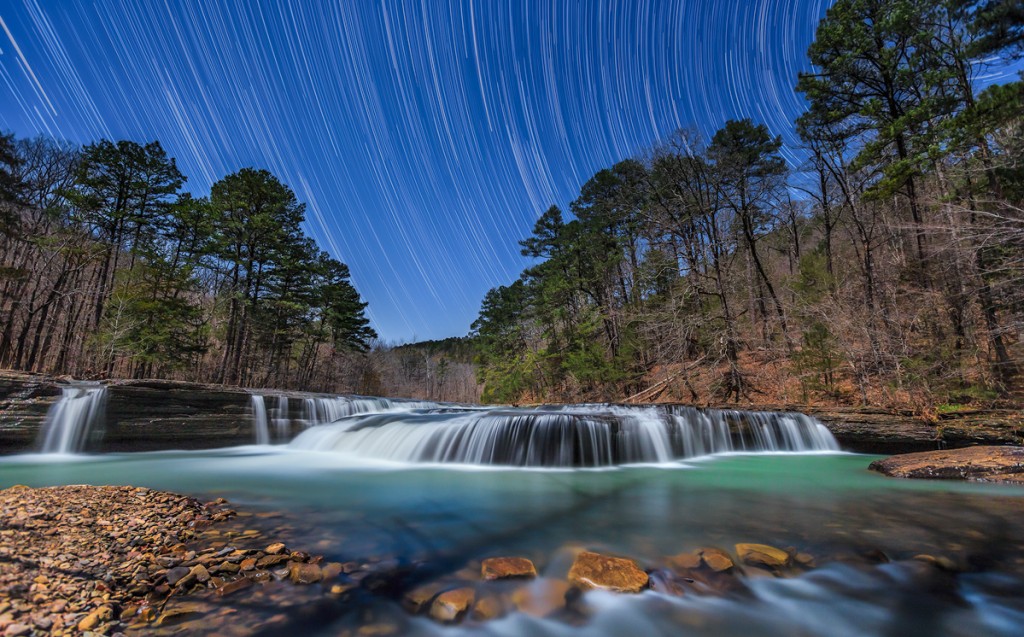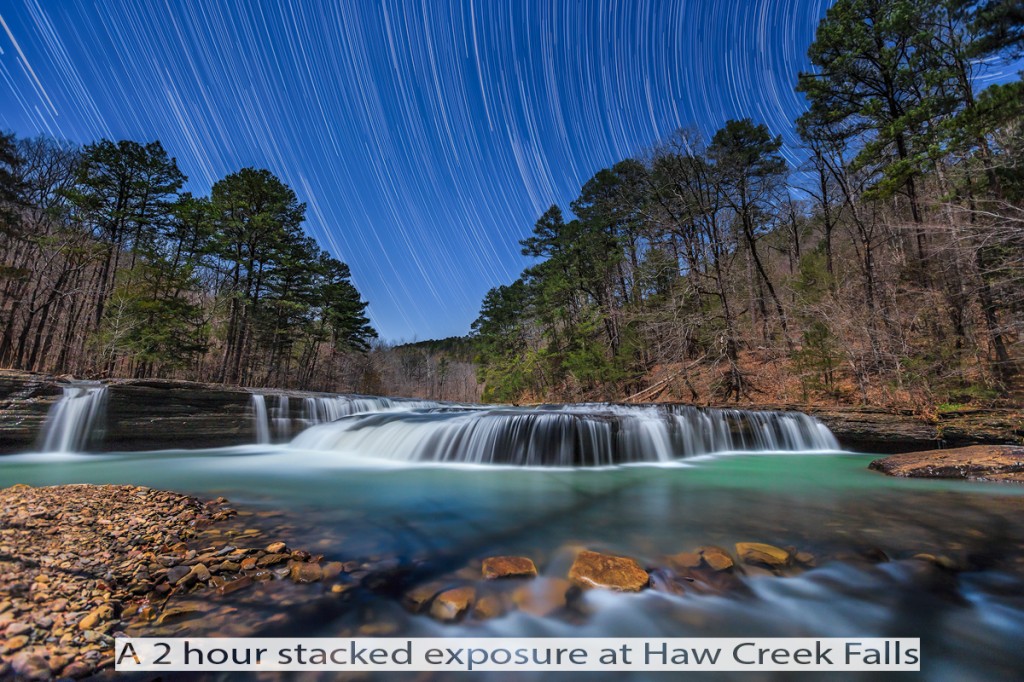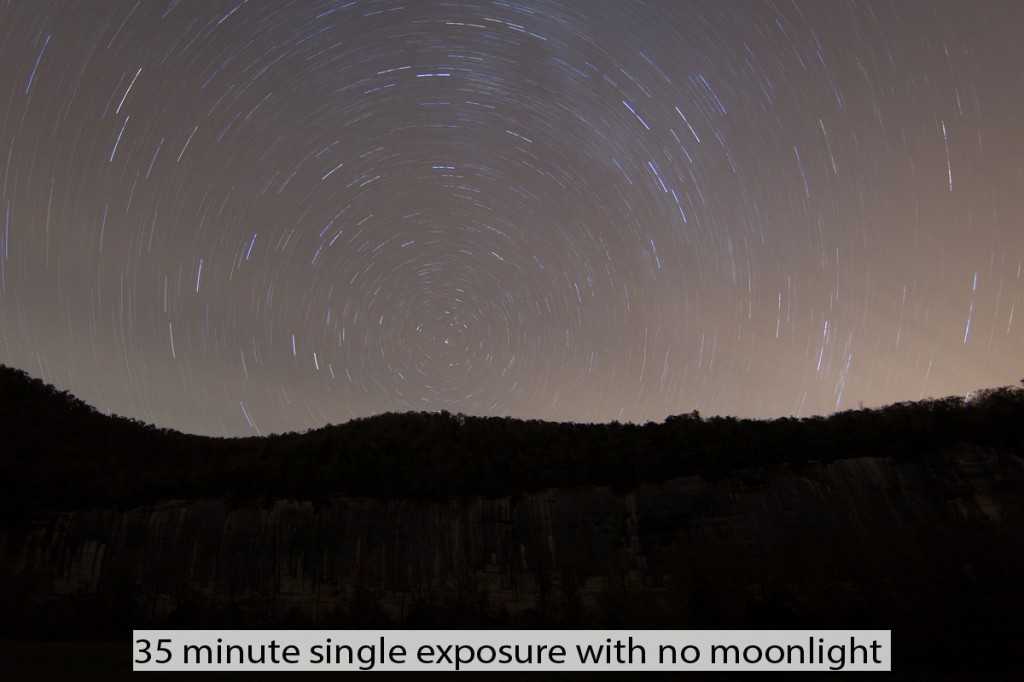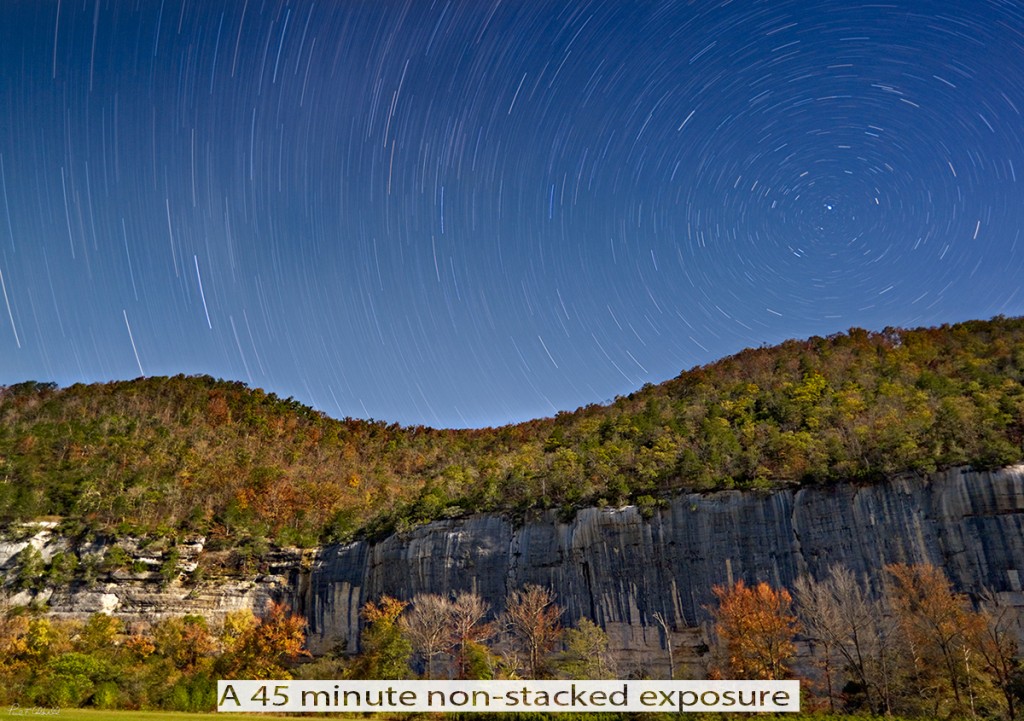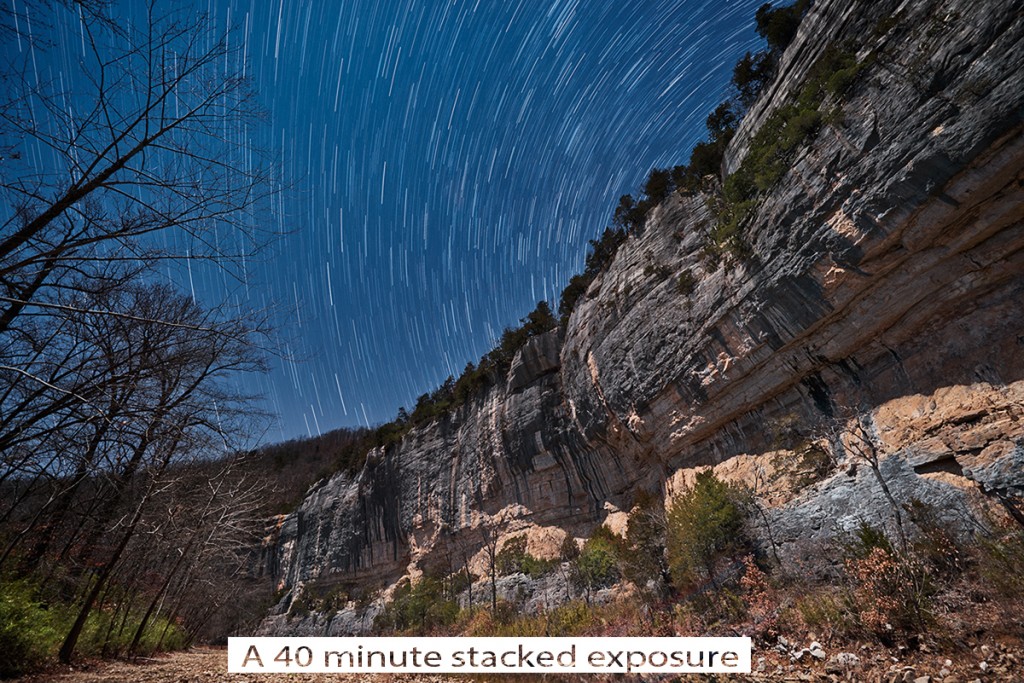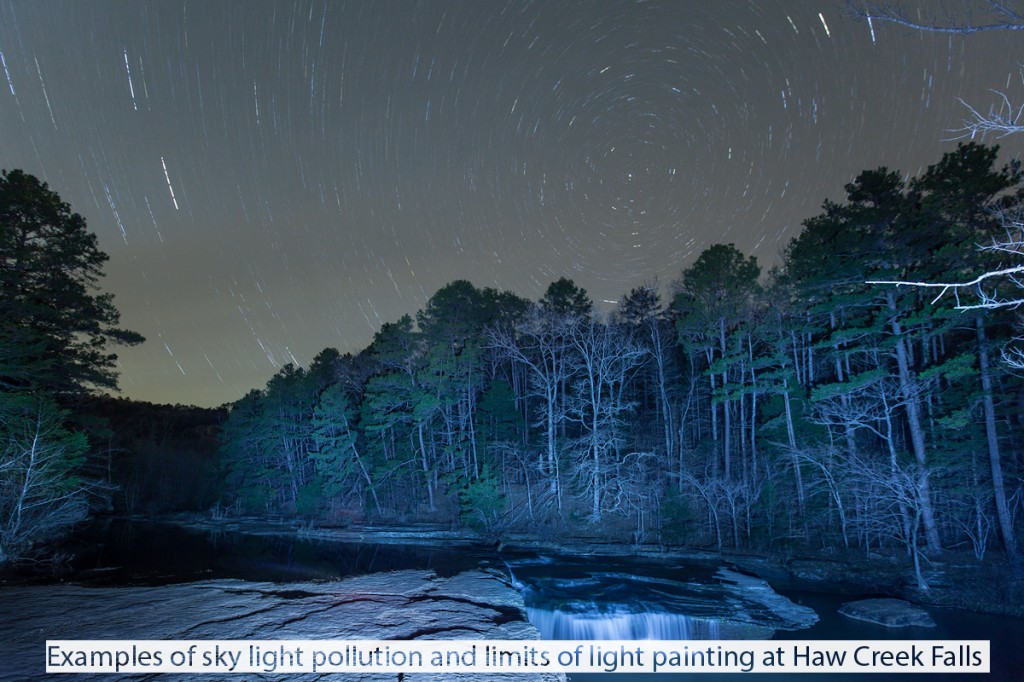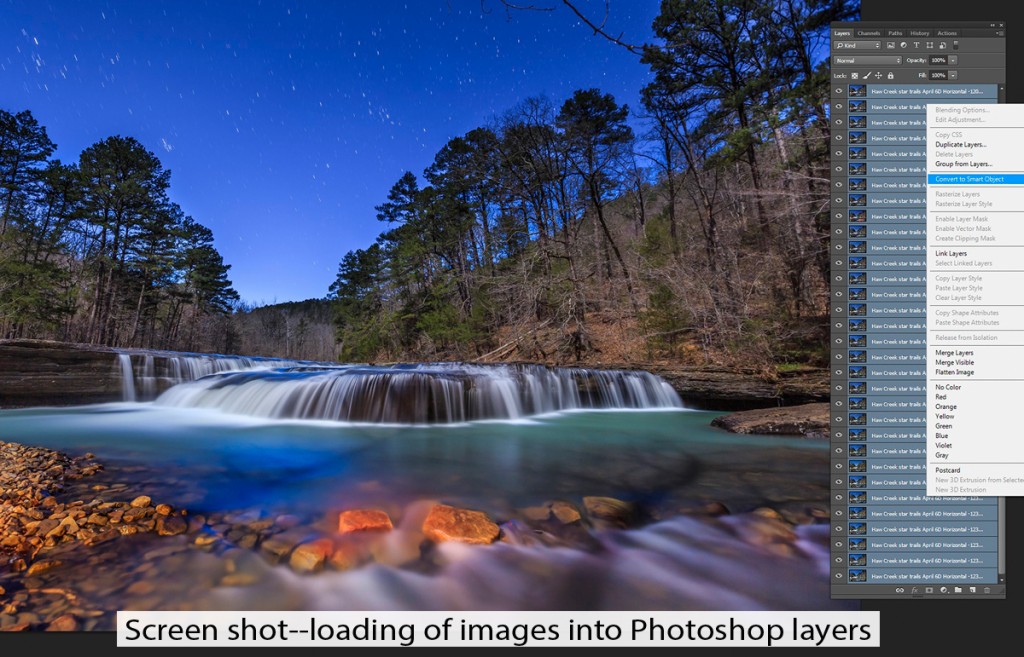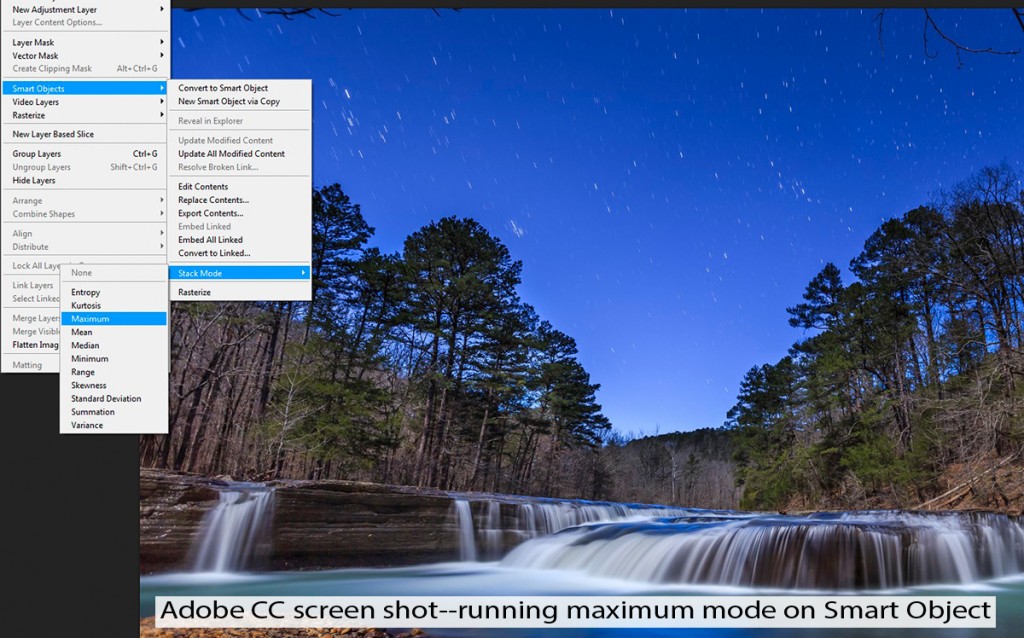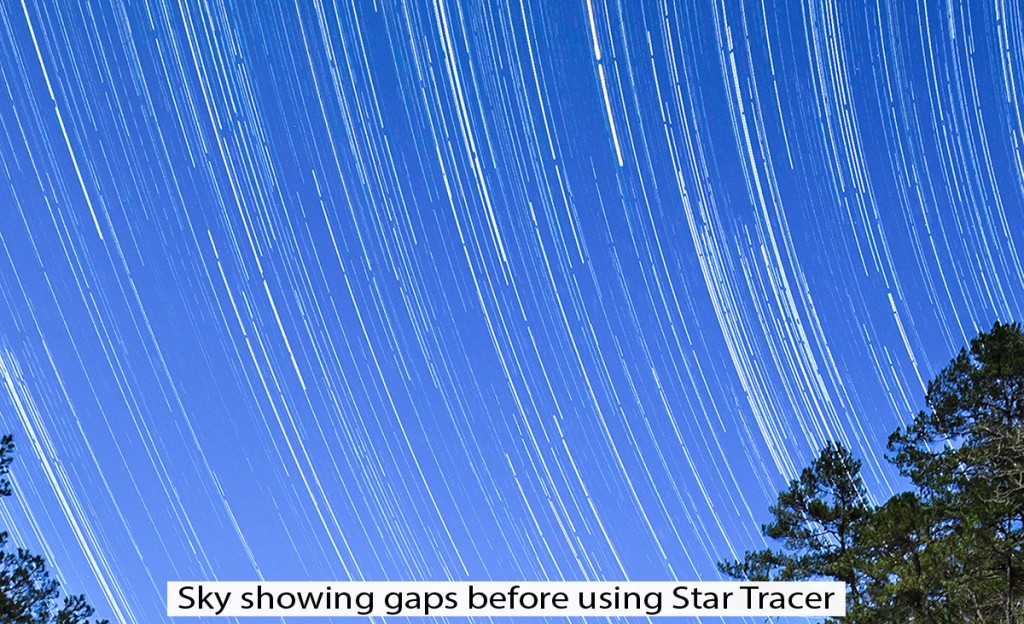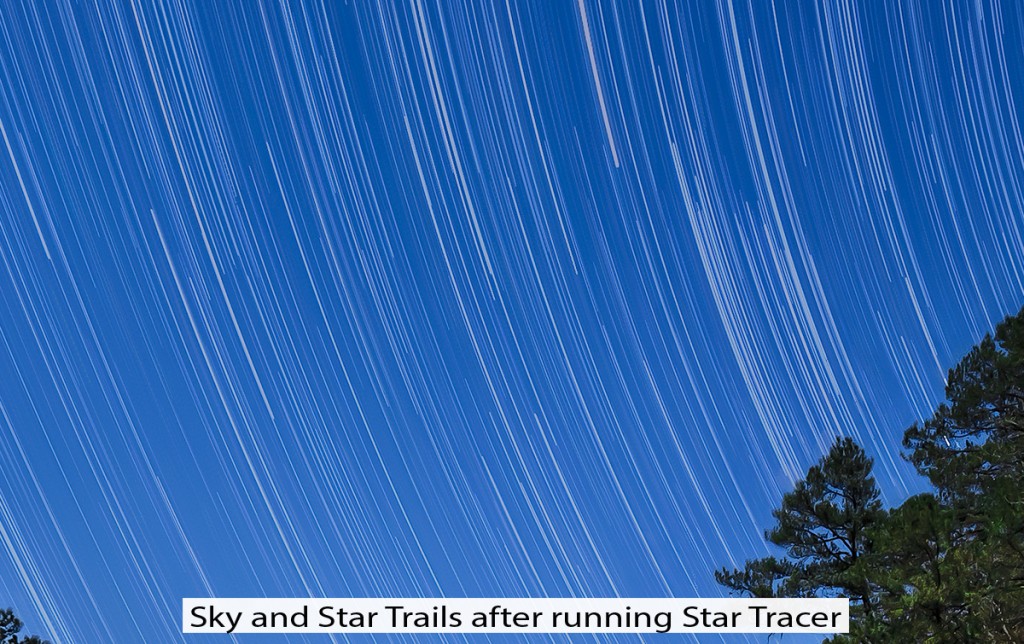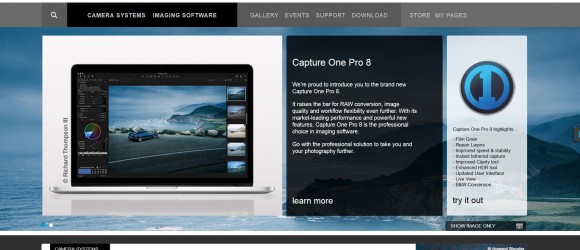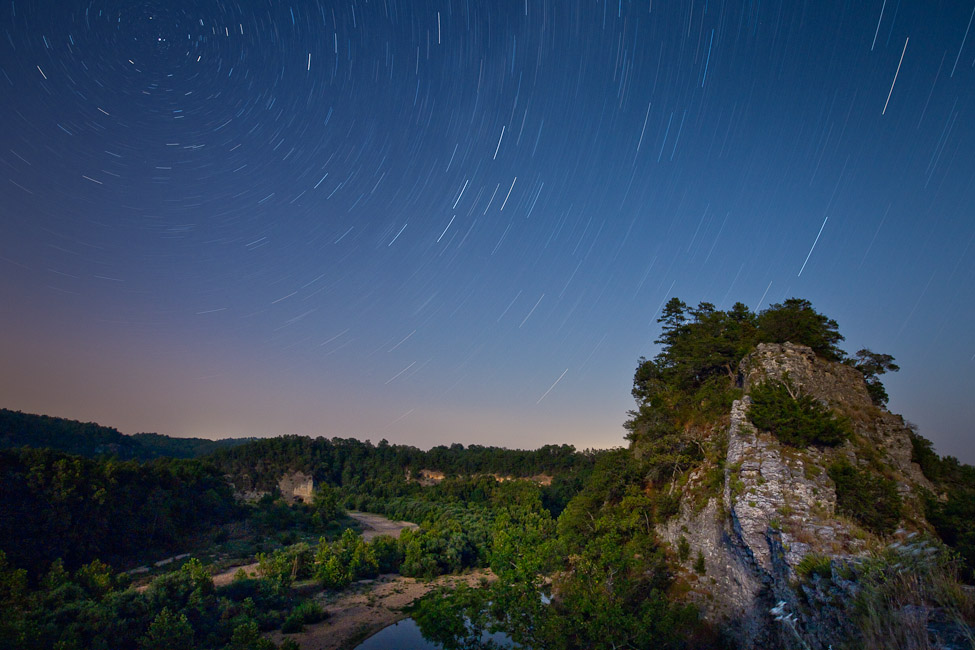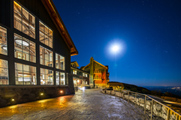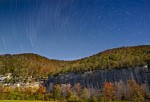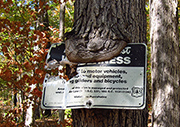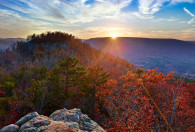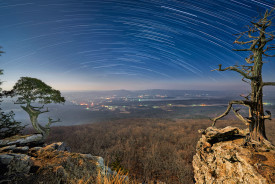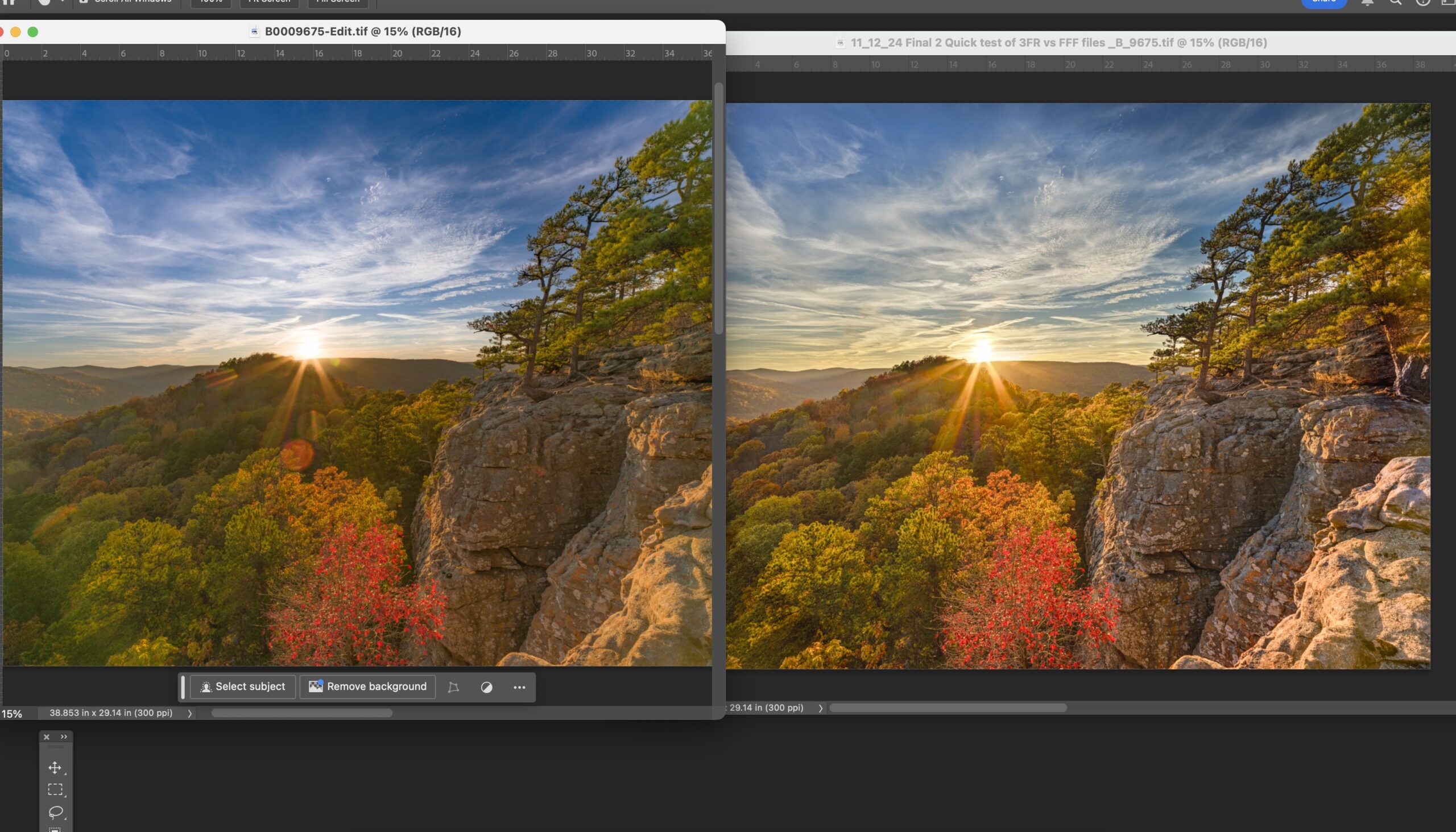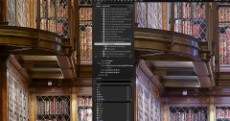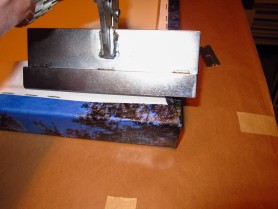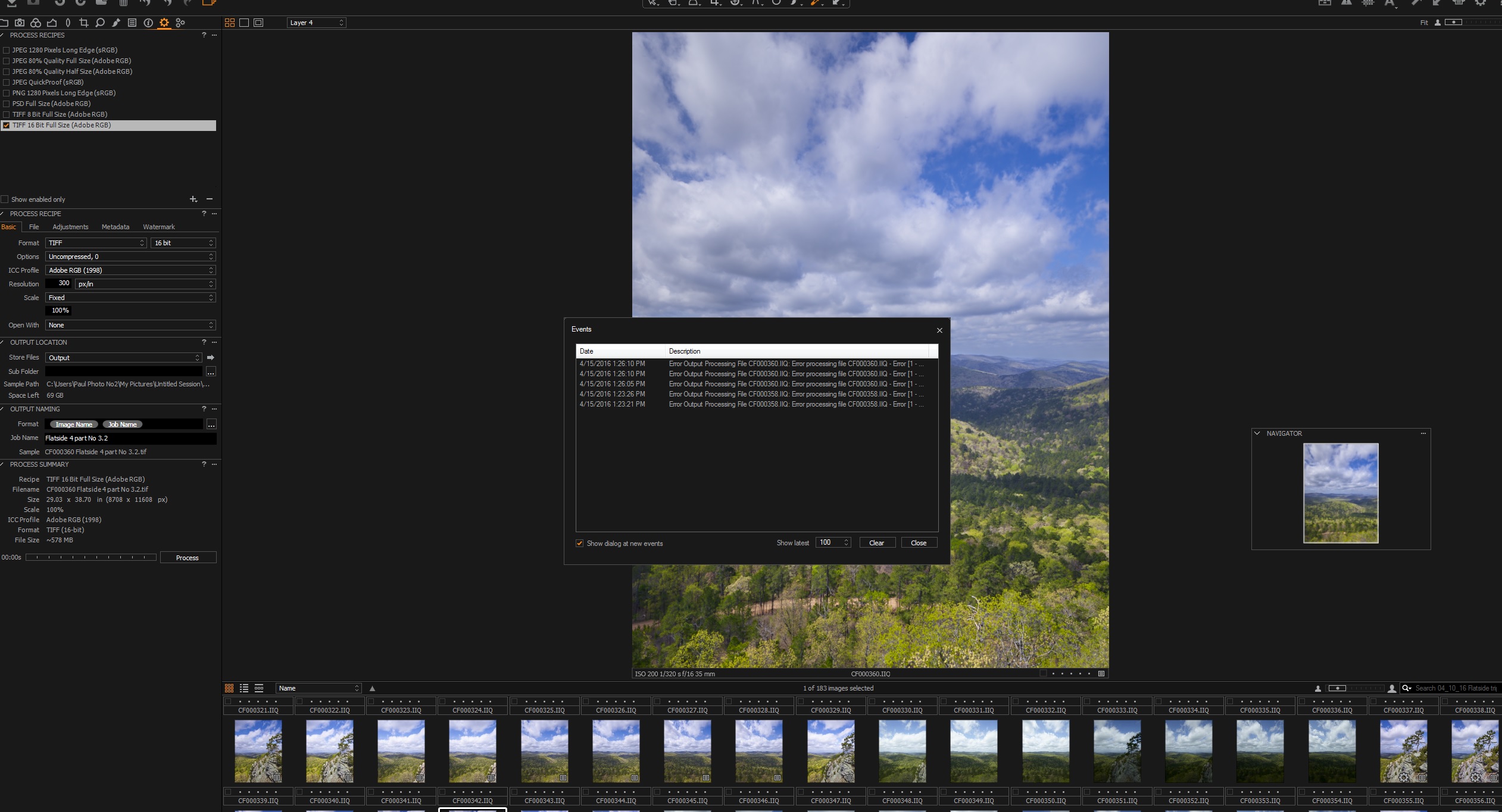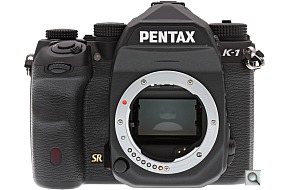Nighttime skies over Havana Arkansas revisited–02-09-15 Featured Arkansas Photography
Taken with a Nikon D800e, 14-24 Lens @ 15mm and F 3.5 in a series of stacked exposures. This shot was taken in February of 2013 on a very clear night from the summit of Mt. Magazine. The view is directly to the south looking over Havana Arkansas. In the distance you can see Blue Mt. Lake and Blue Mountain itself. I believe that Blue Mt. is the on the left. It would be a tall mountain if not for Mt. Magazine as Magazine dwarfs Blue Mountain.
This is one shot but it was composed by taking around 30 or so stacked exposures of 45 seconds. I had a 3/4 moon that night so the illumination down into the valley is all from the moon. I did some light painting on the tree on the left as the moon light was not going to get there until much later. I did not want to wait that long as by the time the moon would provide that illumination it would also be causing both flare and over exposure issues. This night there was quite a bit of traffic down in the valley along Hwy 10, but it just adds to the overall effect to me. I am always amazed when I look down into this valley during the day it’s hard to see any building of significant size, but at night even the smallest light will show up.
I first worked this shot up back in 2013 and thought I had a good version. Recently when viewing that shot, I realized that I had not been very accurate with the star trail work, and in fact I had a dip. This happens when you just slightly move the camera. It doesn’t take much to offset the trails. The best bet is just don’t touch anything until you are done. I say that, but I usually have to stop the series somewhere in the middle to see if I am getting some damaging flare. The Nikon 14-24 will flare with any amount of light that hits the outer element from the side and the flare can be very destructive and next to impossible to correct in post processing work. Flare tends to totally shift the blue of the sky to a red or yellow hue and tend to have a very hard demarcation which makes removal quite difficult.
Here is my first version of this work, and I greatly prefer the new one. I was able to pull out a lot more of the details in the valley. I also re-worked each of the images to try and pull out more of the trails on the left side. In this location the moon will pass from the left side to right and thus makes an even exposure pretty hard to obtain. However working in Lightroom and with some filters I have I pulled out more definition from the faint trails on the left side.
Old Home near St. Joe Arkansas–01/31/15 Featured Arkansas Photography
Taken with a Nikon D800e, Nikon 24-120mm lens, at around 35mm F5.6 iso 100 single exposure. This is one of the places I have driven by many times on the way to Woolum Ford on the Buffalo River. The home itself is in a total state of disrepair, but if you look closely at the front the woodwork there is most impressive. I would love to go up closer, but this is on private land. The weeds that have grown up around the front bothered me at first, but then after looking at the shot, I felt that they just added in. I love that fact that there are no power lines running to the building as they can be a pain to work with in post production. Someone spent a great deal of time on the decorative wood work on the front and most of it is still in place. One of the many old wonders in Arkansas.
Richland Creek in Autumn–12/18/14 Featured Arkansas Landscape Photography
Taken with a Phase One IQ160, Rodenstock 28mm HR lens, F11 for approximately 1 second, iso 50. Richland Creek, which runs from Newton County to the Buffalo River near Woolum Ford, has some of the most beautiful photographic subject matter in Arkansas, if you love creeks. Here you can find huge rocks that have ended up in the creek that had to have originated up much higher on the bluffs. Some of these rocks are the size of a small house and most are the size of a car. Richland creek has several sections that run over flat bedrock and this spot is one of them. This spot is about 100 yards long and starts out directly below Shaw’s Folly Rapid. The foliage on the left back, which is featured in this shot, is full of oaks, maples and hickory trees which on this day were all in full color. There was just enough water in the creek to allow for a movement shot. Normally, I like to have bright sunny days to work Richland, but on this day which was overcast I was able to get one of my best shots of the creek. Using tilt, I have gained quite a bit in overall depth of field so I was able to keep the details of the large rock on the left foreground in focus along with the trees in the background. This was a magic day for sure.
12/14/14 My Thoughts on the new Phase One A Series of Cameras
I have some thoughts on the newly announced Phase One A Series cameras.
Back during the 2014 Photokina show, Phase One announced a joint venture with Alpa cameras. Alpa is one of several camera companies that specializes in “technical” cameras, for medium format digital backs, and film. Others companies that come to mind are Cambo and Arca. Phase mentioned that the partnership would produce several new photography products obviously combined parts from both companies.
About 2 weeks ago, the first series of new products were announced, the Phase One A cameras. There were 3 models, A250, A260 and A280. The Phase One contribution was a digital back, and Alpa contributed their TC camera and with 3 Rodenstock lens options, 23mm HR, 35mm HR and 70mm HR. Alpa also included their excellent iPhone mount with the package, more on this a bit later.
No new products were announced, just existing equipment from both companies, but it was an excellent packaging solution as now any Phase One dealer, just became an Alpa dealer also, as the the A series cameras are sold only by an authorized Phase One dealer. So Alpa gained potential market share with this move. Here is a shot of the Phase One A Series showing the Phase One back, Alpa TC and the iPhone holder for Live View WiFi.
But one thing was announced that may have slipped by many photographers, and that was an automatic LCC correction process. With any tech camera lens, you have to take an LCC (Lens Cast Correction) frame following a exposure. This adds quite a bit of extra processing in post since you have to work up the LCC and also remember to shoot it. With this announcement, Phase One implies that they are going to provide a process that somehow allows the Phase One back to apply the LCC correction to the raw file, so that you won’t have to bother with this later on, and worry about if you forgot to shoot an LCC.
Pricing is a bit high, but it’s a Phase One, Alpa, and Rodenstock solution, so that is to be expected.
Looks like all the models come stock with the Rodenstock 35mm HR lens and are priced below at US list:
- A280 $55,000.00
- A260 $48,000.00
- A250 $47,000.00
You can also order the 23mm HR lens (which has the name Alpagon) for $9,070.00 more and the 70mm HR lens for $4,250.00. It will be interesting to see how many of these units are sold. I expect the sales numbers to be the highest in China as that’s where it seems the vast majority of new Phase One backs are being sold.
At first my thoughts were “so what”, all of this equipment already existed, albeit you had to purchase it all separately through a Phase One dealer and an Alpa dealer (note many Phase One dealers also are Alpa dealers). But, by purchasing all of the various components as an A camera, the photographer gains the support of Phase One for the entire system, which is a nice asset.
During this same timeframe, Phase One announced that it was now possible to send the Live View feed from the IQ250 to an iPhone running Capture Pilot. This is possible since the IQ250 is a CMOS back, and has a much more modern Live View. This to me is a huge feature, as you now can have the iPhone mounted to the A series camera which allows a tilting LCD. The advantages of a tilting LCD are numerous:
- You can position the screen to avoid glare
- The camera can be used in a waist level position
- When working on subject matter low to the ground, you can see your subject on the iPhone
- The iPhone screen is larger and consider the iPhone 6 and 6+ with even larger screens
Now it’s possible to hand hold Phase One back, while using an excellent Rodenstock lens, in either a waist level position (which is much more stable), or traditional eye level. You have 100% control of focus, since you are using Live View. The shutter is still a manual Copol 0, which has to be cocked before each shot, but I feel this a very versatile solution.
There are a few things to consider before you make a decision to go with a Phase One A series camera:
- The Alpa TC (travel compact) camera does not offer any movements, such as tilt, shift, and rise, fall.
- The Rodenstock HR lenses that are offered are all older lenses with smaller image circles @ 70mm vs 90mm on the more modern HR-W lenses
- The A260 and A280 will not have the advantage of using Live View in combination with an iPhone and Capture Pilot.
Looking forward, this is pretty neat solution, as it’s the first one I have seen that allows the iPhone/Live View solution with the IQ250. The fact that the Alpa TC offers no movements, allows for the ability to keep the LCC corrections on board with the back. This would be pretty much impossible with movements as there would be no way to have a preset LCC correct that could be applied to everyone’s movements since they would all be different to some degree. Since the Alpa TC has no movement and the thus the lens stays in one plane at all times, this makes the process of a preset LCC correction much easier.
The only platform that I can really see much advantage with is the IQ250. The IQ260 and IWQ280 both offer WiFi connections to Capture Pilot software but currently don’t offer a Live View connection. Also live view on a CCD back basically is nothing close to live view on a CMOS back. The refresh rate is much slower and you have a real problem with blooming anytime you adjust the aperture. With a IQ250 camera, (note neither the IQ150 or Credo 50 offer WiFi), the photographer has a very neat solution. One that offers the options of using the iPhone as a waist level finder, or just giving you the ability to angle the iPhone out of direct sunlight to allow for better viewing. The Alpa TC has a nice shutter release built into the handle which just adds to the ease of use. With the 3 lenses that Phase One is offering, you can pretty much cover a lot of focal length. One must remember, the IQ250 is a 1:3 cropped sensor so the 35mm HR Rodenstock will have a field of view of 46mm instead of the 35mm view that would be offered on the full frame chips with the IQ260 and IQ280.
This is just the first offering from Phase One and Alpa, and it’s a safe bet as Phase One continues to move forward with CMOS development, more joint solutions will be brought to market.
Mt. Magazine morning Vista–12/14/14 Featured Arkansas Photography
Taken with a Phase One IQ260 & Rodenstock 28mm HR lens, with an Arca rm3di, image created by combining 2 nodal pans. Mt. Magazine, which is the highest spot in Arkansas at around 2700 feet, has some wonderful views. One of the best is from from rock ledge below the Lodge where you have a wonderful view of the Blue Mountain, and Blue Mountain Lake off in the distance. This view is looking southwest, and shows the fall colors at peak or near peak. The deciduous trees in the area include, Maples, Hickory and various Oaks. You can also see the effect of the massive amount of forestry cutting in the lower valley which is beyond the boundary of the State Park where all the trees are now pines. These are not the natural pine to Arkansas, the short leaf, but instead Loblolly and or Slash pines, both of which were planted after the clear cuts were made. All of the lower foothills of Mt. Magazine are covered in this type of tree.
This is a hard shot to get in one frame with a 4:3 ratio camera like the IQ260 Medium Format back, so I worked in a series of pans, where I set the 28mm Rodenstock at a spot on my tripod that was close to the nodal point for the lens. This allowed me to pan across the scene and then combine the images into one larger frame later on. On this day, the sky was a radiant blue with some very high cirrus clouds that were rolling in from the west. With a tech camera like the Arca rm3di, and the Rodenstock 28mm lens, this type of shot is a bit more difficult since you have to correct for the color cast the lens creates. I used the Rodenstock Center filter on the lens and a linear polarizer to enhance both the blue in the sky and fall colors, as the sun was over my left shoulder and provided perfect conditions for polarization.
This is popular spot on the weekends, but during the week, most times you will not find anyone around so plan your trips accordingly. Make sure you take enough time to drive around the entire summit of Mt. Magazine as there are many great vantage points for photography.
The Arca Swiss DSLR-2–A perfect companion to the Sony A7r (Part 1-camera review)
Authors note: Since this review was written, Arca has started to ship the new Universalis. This is a smaller and more compact version of the DSLR2, which will have some new features and functions, however the basic operations of the Universalis will mirror the DSLR2.
For the landscape photographer, one camera in the mirror-less category stands out by far more than the rest, the Sony A7r. This camera, with its 36MP sensor and excellent dynamic range offers a huge range of photographic options. However there is one area where the Sony A7r is weak, the range of lenses in the FE (full frame mount) that Sony offers for it. In fact it seems that most photographers using the A7r, bypass the Sony lenses and work with non-Sony lenses and adapters. With this in mind, I recently was able to use the A7r with a modern in-line view camera, the Arca M2 configured to work with DSLR’s. In this configuration is is called the Arca DSLR2. With this setup, the photographer is given a new level of photographic capability with the use of Rodenstock and Schneider Digital lenses and any other lens with a manual aperture ring that will accept the Arca R mount.
With the Arca DSLR2/Sony A7r combination the photographer has a huge advantage as they now can take advantage of traditional view camera movements. Why would this be something a landscape photographer would be interested in? Since the Sony lenses available for the A7r (4 at this writing) is very limited. Secondly, no Sony lenses have ever been produced in a Tilt Shift design, like the Canon TS-E or Nikon PC-E lenses. With the DSLR2 you now have the ability to use Rodenstock/Schneider lenses, which are the pinnacle of lens design, both wide angle and telephoto. On top of this with the DSLR2, you have the ability to add movements to any lens. This will allow you so much more control over the depth of field of the subject. With this combination you now have the ability to use one of the most powerful 35mm digital sensors so far developed, the Sony 36MP CMOS, with the best optics currently available. In the past, these lenses were only an option with higher medium format digital cameras, or film/view camera combinations.
Major Components of the Arca Swiss DSLR-2
A. Acra L Bracket with Sony A7r G. Front Standard with Swing and Tilt Control
B. Arca Lever operated Quick Release H. Swing Control Knob
C. Shift Control I. Tilt Control Knob
D. Rear Standard with Focus Control and Lock J. Arca R Bayonet Mount
E. Arca Connecting Bracket K. Leather Bellows
F. Arca Main Rail L. Arca Magnetic Bellows mount to Sony E mount
The Arca M2 has been around for many years, but in the past most of the use of this excellent platform has been with film and medium format digital backs. Now with some slight improvements, the photographer can use all of the advantages of an in-line camera on the A7r:
- Tilt
- Shift
- Swing
- Rise/Fall
- Precise focus control
In addition, these important movements can be used with various digital lenses:
- Rodenstock: 32mm HR-W, 40mm HR-W, 70mm HR, 90mm HR 105mm HR
- Schneider: 35mm SK, 43mm SK, 47mm, 60mm SK, 120mm
This is all done with the implementation of the Arca R mount for the various lenses, and a special bellows for the A7r that uses a magnetic attachment for the bellows to the e-mount of the A7r.
(In this photo, you can see the brass mounting ring where the R mount receptor is, attached to the front of the bellows. The large circular threaded mounted (black) that is on the Rodenstock lens clearly shows how the threads on the R mount. Notice in this picture, a white dot on the brass ring and a slight indentation on the lens mount, these are to assist in lining up the lens when mounting.)
First let’s take a look at the Arca DSLR2 and the various components.
The Arca DSLR2 consists of the following basic parts:
- Bottom rail and Arca lever locked attachment, with traditional Arca foot
- Front standard with swing and tilt control
- Rear standard with rise/fall and shift control and focus control–both gross and fine
- Bellows with magnetic mount
- Arca e-mount magnetic bellows attachment
- L-bracket for A7r
- R mount bayonet attachment for lens
Bottom rail and Arca mount:
This portion of the DSLR2 is what everything else will be attached to. The rail is geared and allows movement of the front and rear standard forwards or backwards to obtain precise focus. You can also add a 2nd rail which will double the length which is good for macro or table top photography. There is a bracket on the bottom of the rail that is placed in any tripod with an Arca compatible head. In this photograph at the beginning of this review, you can see the top of an Arca B1 tripod head and how the entire DSLR2 is placed into the tripod. The Arca attachment bracket is lever operated to allow for quick removal from the rail when necessary.
Front Standard with swing and tilt control:
The front standard holds the R lens mount, the front part of the bellows and has the tilt and swing controls. The lens will mount with a simple twist into the R mount and then is locked into place.
[new_royalslider id=”2″]
(To view the images in full screen, hit the double arrows towards the upper right corner)
You can see on the right side of the front standard, two adjustment knobs, the top knob is for tilt the bottom knob is for swing. A lens can be tilted as much as 25 degrees, up or down and the tilt amount is shown in a clear white numeral scale. The amount of tilt is very precise as the tilt is geared. The swing can be as much as 45 degrees to right or left and is also controlled by a geared process that allows for very small adjustments. Here is a close of the front standard showing the tilt and swing controls.
[new_royalslider id=”3″]
(To view the images in full screen, hit the double arrows towards the upper right corner)
Rear standard with rise/fall and shift control and focus-both gross and fine:
This part of the Arca DSLR2 is where a lot of control occurs, at least with my style of photography. The rear standard has a push pressure attachment spot where you will insert the L-bracket with the A7r mounted. Once the camera is centered (more on this in a bit) you now have control over focus, tilt and rise and fall. The focus control is in two knobs, a gross movement and fine movement. You focus the camera simply by using the Live View screen and then moving the camera forwards/backwards until the subject comes into sharp focus. With the Sony A7r this is very easy since the camera has both an excellent LCD and EVF both with focus peaking. I was able to obtain sharp focus with each lens I used.
[new_royalslider id=”4″]
(To view the images in full screen, hit the double arrows towards the upper right corner)
From the rear you can shift the camera body as much as 30mm right or left. I found that with the A7r and the Arca DSLR2, that I was able to obtain useful images with as much as 18mm of left and right shift. You can also combine that with rise and fall and create a huge 9 part image that would be well over 150mp in overall size. The maximum rise and fall will be limited by how much of the rise is needed to center the camera, this then becomes your new starting zero. Since the Arca DSLR2 was designed around full size 35mm DSLR bodes, when you use the Sony A7r, you need to adjust the height upwards to account for the much smaller size of the Sony A7r. One facet of this design is that Arca may want to create a more specialized mount for the A7r which will allow you to start at zero on the rise fall scale. However due to the large amount of rise and fall that is available, over 40mm total there is plenty left to shoot with.
Bellows with Magnetic mount
Arca provides a black leather bellows to cover the space between the Sony e-mount lens opening and the rear element of the lens in use. This bellows is permanently attached to the rear of the R-mount on the front and has a round magnetic attachment which fits very snugly to the e–mount bellows ring. The bellows has enough give to allow a huge amount of forward/rearward focus movement and front swing and tilt. I had no light leaks with the bellows when attached with the magnetic mount. The magnetic mount allows for a very quick snap on an off of the bellows when either changing the lens or moving the camera from a horizontal to vertical position.
Arca e-mount magnetic bellows attachment
[new_royalslider id=”5″]
(To view the images in full screen, hit the double arrows towards the upper right corner)
Simply stated, this is an e-mount ring. It quickly fits into the lens mount of the A7r and the front side is smooth and allows for the attachment of the rear of the bellows. The ring is anodized in a matte black color to keep reflections to zero and is very effective.
L-bracket for A7r
With the Arca DSLR2 configuration, Arca includes one of the adjustable L brackets to mount to the A7r. This bracket is very sturdy, light weight and allows for a very easy adjustment of the A7r during the centering process. It also allows for a very quick 90 degree rotation of the A7r from horizontal to the vertical orientation. In the field, I found it best to just leave the L bracket attached to the A7r. The L bracket attaches to the A7r via the tripod attachment threads in the base of the A7r camera body.
R mount bayonet attachment for lens
The standard for all Arca lenses is the R mount. This is circular mount that is threaded on both sides, mount and lens mount. The threading is very similar to how a deep sea diving helmet is threaded, so only a very short twist and the lens is securely mounted. The mount is brass and should last forever. The teeth are very closely spaced so you need to be sure not to cross thread the lens when mounting. With the Arca DSLR2, the photographer can mount pretty much any lens that will accept the R mount plate, which should include any of the Rodenstock/Schneider lenses available, not just the more recent digital lenses from these companies. Note, that the Rodenstock 23mm and 28mm will fit, but you will not be able to obtain infinity focus as the rear element can not be moved close enough to the Sony sensor. Each of these lenses will have a Copol 0 or 1 shutter so you need to remember to set the lever on the shutter to open the lens wide open as you will be using the shutter of the A7r. However the aperture will still be set on the Copol 0 or 1 shutter.
The widest lens I was able to use on the Arca DSLR2 was the Schneider 35XL. I have been told by Arca that the Rodenstock 32 HR-W will also work, but I did not have one of these lenses to test with. On the longer side, really any telephoto lens should work with no problems, you will just have to make the necessary extensions on the rail of the front standard.
Setup of the DSLR2 with the A7r
Once you have assembled the Arca DSLR2 it can be carried in one piece. It’s a bit bulky but I found it fit in about the same amount of space as my Arca rm3di. The DSLR2 is about 4.5lbs with the A7r mounted and I was surprised that it weighed about the same as my Arca rm3di with a digital back and lens mounted. I carried the DSLR2 without a lens mounted in the field since it’s such a simple operation to mount the lens in the bayonet when you reach your shooting location. So from my pack, I had the front and read standards mounted and the front lens mount/with bellows.
Setup is very straight forward. Simply mount the rail to your tripod head with the foot. Remember the foot is released via a lever so you can slide it to the optimum location before you mount it to the tripod head. Your tripod head needs an Arca style mount, which is very common in the industry.
Once the DSLR2 is secure in your tripod head, mount your lens. Be careful with this step so you don’t cross thread the R mount. Once this is done, all this is left is to center the rear lens element on your A7r sensor.
This process takes a bit time as each lens used will be a bit different. The goal is to line up your camera sensor with the rear element of the lens in use so that the rear element is centered on the sensor as best as possible. This is done all by visual sighting with the rear cover of the bellows pulled back over the rear element of the lens. Take your time here since if you are off left/right or up/down then you image will not be on the center of the sensor to start so if you apply movements they will be off also. Once you feel you have the rear element lined up, take the bellows back over the rear element and attach it to the Arca magnetic e-mount ring, and you are ready to shoot.
Impressions from shooting with the Arca DSLR2 and Sony A7r
This is very impressive setup. I use an Arca rm3di camera with a Phase One IQ digital back in a lot of landscape photography. I moved quickly from a 645 style DSLR camera body to the rm3di, mainly because of the overall lack of optical quality in the wide angle medium format lenses currently available. The rm3di is only an enabler, but it gives me the ability use much better wide angle and normal lenses on my Phase One digital back. I prefer to use movements in most of my photographs to enable a greater DOF and I tend to use wide angle lenses in my photography. By allowing for tilt and shift, I can gain a greater focus perspective on my subject and create panorama style photographs with great precision. However there are many limitations to this setup.
With the A7r, and the DSLR2, I was able to use a “real” live view screen with focus peaking. With the addition of the ability to zoom into 100% to check focus, there was never any doubt that my subject was in perfect focus. The fact that I was no longer limited to the base ISO of my camera (as is the case with a CCD based MF back) and instead roam from ISO 100 to 1600 with impunity was a huge benefit to me. I could set an aperture on my lens then with live view on the A7r, focus on my subject and thus eliminate any issues of focus shift. I no longer needed a scale and distance meter to gauge my focus, I could see it as I was now using a camera with excellent live view.
The camera controls of the A7r, were simple for me, I shot in manual mode and set the camera to accept non-Sony lenses. THIS IS A MUST OR THE CAMERA WILL NOT FIRE. I quickly tried all the various lenses I have and was impressed with the results from all of them. Since these lenses are coming in closer to the sensor, I would recommend still shooting an LCC frame especially if you do any movements. I used Phase One’s Capture One Pro Vr 7 for all the conversions and had no trouble with any of them.
I quickly realized that this solution was a perfect one for my style of photography and found I developed a working rhythm, where I shot everything I needed in the horizontal plane first, then rotated to vertical and shot those series. Once you get used to the process, the setup time is much less then bringing an Arca Rm3di/Digital back into operation. You can carry the entire Arca DSLR2 assembled in your pack if you wish, but I chose to remove the lens and bellows just for precaution. I did leave the A7r mounted to the DSLR2 the whole time, and used the body cap to protect the sensor when the bellows was not mounted to the A7r.
I have long known just how good the A7r sensor is and the amount of dynamic range it’s capable of, but I never considered that I could be using the same lenses I use on my digital back with an A7r. The cost of entry to this system is much less than a Medium format digital solution. The costs would be:
Sony A7r $2,300.00
Arca DSLR2 $4,300.00
VS
Phase One IQ260 $39,999.00
Arca Rm3di $ 5,870.00
You still have to pick up a lens or two, but you have so many options here it’s hard to list them all. It’s very easy to place an R mount on any of these lenses, by simply unscrewing the rear element. Most of the lenses will come with a Copol Shutter 0 installed already. The cost of the Arca R mount is around 500.00 per lens and each lens would need such a mount. NOTE, any Arca lens already in the R mount works perfectly. If the lens is configured for the rm3di, all that has to be done, is remove the R mount from the various Arca lens tubes which are used for the rm3di. There is no issue with offsets or other critical adjustments as your focus is determined by the simple process of moving the camera body forwards or backwards. The lens stays in one location.
After I used the DSLR2, I quickly realized that if this solution had been available when I bought into medium format digital, I would have gone the other way, and purchased the Sony A7r and a DSLR2. For someone just starting out with large format photography, and wanting to learn about movements and how they affect photography, the Arca DSLR2/A7r solution is an excellent place to start.
Lenses I used and feedback on each:
My main goal with each lens was to see just how far I could shift each before color cast became too harsh. I was not as interested in rise and fall for this testing.
- Schneider 35XL apo-digitar with center filter. On center, the 35XL worked very well, but when I attempted to shift, I saw considerable color shifting by 8mm of shift. If I took the lens to 10/12mm of shift, the amount of color saturation loss was too much to recover with a standard LCC in Capture one.
- Rodenstock 40mm HR-W. This lens allows for excellent movements. I found I could get to 16mm of horizontal shift with minimal loss of color and saturation loss. The shots were easily cleaned up in Capture One with the LCC. The 40mm will actually get to around 18mm of shift but on such extreme shifting, many times I felt that the color loss was pretty extreme especially with a blue sky.
- Schneider 60mm XL apo-digitar with center filter. This lens was by far the best all-around performer. Shifts of 15mm were easily obtained and even 20-22mm was useable. The Schneider 60mm was a perfect companion to the A7r.
- Rodenstock 90mm HR sironar-digital. The 90mm Rodenstock gave me the best range in movements, up to 25mm of shift. There was very little color cast even with 25mm shifts. The ability to use Live View to focus made the 90mm a pleasure to use. Even though the 90mm HR give the best range in movements, the focal length is a bit too long for most of my work.
Pros:
- Low cost of entry
- Excellent solution that allows upgrading to Medium format at a later date
- Allows the use of the best optics available to photography to date, Schneider/Rodenstock digital lenses
- Sony A7r has excellent dynamic range and ease of use features
- Very stable shooting platform with moderate size and bulk
- Can be easily carried in the field
- Allows for a vast array of movements which improve the overall photographic solution
Cons:
- Need for understanding of a rail focus system
- Very manual shooting style no Auto Focus
- Setup is very critical in that you need to be centered on the sensor
- Sensor is exposed to the elements a lot more than normal use, it’s going to get dirty
- LCC frame is recommend especially for shots with movements
- There is a bit of a learning curve for someone coming from a non-technical camera environment.
Overall I would highly recommend this solution to any landscape photographer interested in the best optical performance for their work.
10/14/14 Featured Arkansas Landscape Photography–Sunset at Roark Bluff on the Buffalo River
Taken with a Canon 5D MKII, Canon 14mm F 2.8 lens, in a bracketed series of exposures @ iso 200 This one is a special shot as it was one of those photographs that was just pure luck. I was up on the Buffalo River with Bob Shull, mainly to work the night skies, and we were just up on the river setting up our cameras. I had been looking downstream as the moon was starting to rise and it was in a very nice position. I had left my Canon 5D MKII setup for a upstream shot of Roark bluff for later that night. The evening skies had been cloudless, so I was not very interested in a sunset. I remember for some reason I looked around, probably due to a noise on the river, and wow, all of a sudden a bank of clouds had rolled at just the right time and they were on fire! I had to shoot the 5D MKII in a series of bracketed exposures as I knew that I would not be able to pull in the entire exposure with just one frame. This scene only lasted about 6 minutes and then the sun dropped below the bluff. My first series, missed the reflections of the sunset on the water at my feet. The river was not dead calm, but I still was able to pull in the reflection of the sunset on the water and the river rocks.
This was one of those once in a life time lucky lighting shots, that unless you happen to live on the river and can be out there everyday, just doesn’t happen very often. This was one of the last major photographs I took with the Canon, as I was in the process of transitioning to my Nikon D800, however I was much more familiar with the Canon at the time, so I shot with it.
09/28/14 Featured Arkansas Landscape Photography–Midnight at Haw Creek Falls
Taken with a Canon 6D, Canon 16-35 lens, at F4, iso 400, 2 hour time lapse photograph. This photograph was obtained by taking a series of 2 minute exposures from 10:00 pm to 12:15 am at Haw Creek Falls in the Arkansas Ozarks. I used a Canon 6D and a focal length of 18mm to take a series of 2 1/2 minute exposures. Each exposure was taken as raw file and developed in Lightroom, then I stacked them in Adobe Photoshop to capture only the motion of the earth over 2 hours which created the “trails. The blue color to the sky is from the moon, which was just a bit past 1/2 waxing. The moon adds both excellent ambient illumination to the night sky, giving it a blue hue, and also greatly adds to the landscape portion of the photograph. There was no light painting used on this photography, it’s all the light from the moon. I prefer this greatly over using artificial lighting, by painting as the moon just works better. You can read more about this technique in an article I wrote: Stacking for better nighttime photography. This photograph was taken in April of 2014, and spring was very late this year as can be seen in the trees on both banks of the creek.
I been working for a shot like this from Haw Creek for over 3 years. Catching the conditions all together can be harder than you think. You need a good flow of water, but not too much, as was present in March. The moon needs to be waxing for this shot, not waning or you will be up way to late waiting on the moon to appear. A clear sky is needed, with no clouds if possible and this does not always work out, as over 2 hours it’s quite common to see a front blow in. Also it work best if there is little to no wind. But since I am stacking I usually can find one of the stacks that has less wind noise than the rest.
This shot has it all, as you have great water, running over most of the ledge, and excellent play of shadows on the foreground. I am looking to the northwest, you can barely see where the north star is up in the upper right corner of the shot. It’s not very easy to get a good shot of the falls and the north star from below the drop, but the wide angle lens I was using did grab a nice portion of the sky. Of all the photograph I work with, nighttime stacking takes by far the greatest amount of time, both in the capture of the images and post processing, however I love the look of what I can create.
09/23/14 Using Stacking for better Night Photography results
I have found that working at night in Arkansas can bring out some amazing photographic opportunities, like the photograph below.
Since early in 2008 I have been fascinated by one facet of night photography—the creation of star trail photographs. Capturing the motion of the earth over a period of time and blending the light of the distant stars into different lines of varying brightness is my mission. My first attempts consisted of just leaving the shutter open over a period of time and varying it from 30 minutes to 1 and half hours. My initial thoughts were that the best conditions for shooting the stars would be nights with little or no moonlight. The results in my location (Arkansas), were a bit disappointing since the ambient light from nearby towns and even a single home would give the sky a yellow/orange color. If I tried to change this yellow sky color in post processing it also influenced the color of the star trails making them red/yellow.
In this image, you can see an example of how light pollution can totally turn the night sky yellow/amber and the non-sky parts of the image have no details. Attempting to pull up the foreground produces a noisy and non-detailed image.
Things changed for me quite by accident as one night I was out when there was a half moon. The results from this short 20 minute exposure with moonlight moved things in a totally different direction for me. Instead of the yellow/orange sky, I now had a beautiful blue hue, with pure white star trails. Even more impressive was just how much the surrounding landscape had been illuminated. Now instead of a dark silhouette I could now see most of the details of the landscape. The colors all had a naturally strong saturated look and I was hooked. However after a few months of shooting in this mode, I noticed that as my single exposures approached 40 minutes the trails started to become faint to a point where only the strongest stars continued to show trails.
This is a 45 minute single exposure from a Phase One P45+. There is a good balance however only the strongest stars are showing through. There is considerable wind blur on the trees along the bluff.
If I tried to pull the exposure of the sky down, I lost many of the faint trails. I tried a few different solutions with filters, but nothing seemed to really give me the sky that I was looking for, one with a nice deep blue hue and filled with star trails. Then I read about some photographers that were stacking their exposures and I became very interested in what my results might be from night exposure stacking.
This is a 1 hour exposure taken in approximately 2 minutes stacked exposures. Notice the vastly greater number of star trails and the lack of motion blur.
The idea of stacking comes from photographers working with time lapse capture. The idea is simple enough, instead of one long single exposure, take a series of short exposures and then blend them together in Photoshop. By using Photoshop I found that you can create a smart object from all the stacked exposures and then run a series of blending modes on the smart object that capture only the movement of the stars in the night sky, creating the trails. Each night the period of time of each exposure will vary and it takes a few attempts to get just the right time for the best segment. Ideally I can find an exposure/aperture combination that shows bright stars but also allows for illumination of my landscape features. Since most exposures will be longer than 30 seconds, you need an intervalometer. With the intervalometer, set the interval to 1 and then set the total time of each single exposure. Then set the camera to continuous mode and for blub exposure. For example, if your exposure time for each segment is 2 minutes and 30 seconds, for a 2 hour exposure you will take 52 individual images to stack together later.
Stacking has several advantages over a single long exposure:
1. You have more interesting subject matter overall
- Since you now have the ability to see the landscape subjects that are illuminated by the moonlight, you have a much more interesting photograph. The illumination provided by the moon can be quite eerie at times and offers a unique look to the final photograph.
2. The ability to handle wind motion:
- During single long exposures, more than likely you will have some wind. The wind over a period of 2 hours can totally blur your trees to the point that it will actually ruin the photograph.
- Stacking allows you to find the best single exposure of the foreground and layer it back to the final image.
3. Hundreds of distant stars are brought into view:
- With night photography, you will get more distant stars the wider you can open the aperture so ideally you would try to work with aperture ranges of F2.0 to F4. Any wider and you will start to run into DOF issues with most lenses. Stacking allows you to work with these wider apertures. In contrast, working at F2.8 to F4 with a single long exposure of 1 hour most likely will cause the sky and stars to be overexposed.
4. Much more flexible workflow:
- Since you are stacking you will have many different images to work with in your landscape portion of the image. You may want to pick several and blend them together to take the best parts of each. You also may want to experiment with light painting on one segment. If it doesn’t work out, you don’t have to use that part of the stack, however if you light paint on a single long exposure and make a mistake, then you have ruined the entire sequence.
This is a 35 minute single exposure where no moonlight illumination was used. The combined light painting still really did not begin to pull out the details of the tress along the bank and the light painting only provides a 1 dimensional form of illumination.
5. Better control over plane trails:
- I have yet to work a night where planes did not fly over. If you are stacking, you can take out the plane trails before you run the blending modes to combine the images. Plane trails will always be some form of a straight line and will contrast sharply with the curved star trails in the night sky of your image.
6. Noise of a single long exposure vs stacking multiple exposures:
- Over the time of a single long exposure you can expect your camera to generate quite a bit of heat and thus get excessive noise and stuck pixels. If you stack, the shorter exposure times will contain less noise and fewer stuck pixels. This can make a big difference in the final image.
My current camera selections are the Nikon D800E with the 14-24 F2.8 lens and the Canon 6D with the 16-35 F2.8 lens. Both of these cameras allow you to turn off the long exposure noise reduction, which is critical. If you leave it on, then you will have a mandatory dark frame between each segment, which creates gapping. For both of these cameras, I use the accessory grips with extra batteries so I can get the longest operating times from each camera. I use a wired intervalometer with each camera to control the exposures. My goal for night photography is to maximize my sky view so I tend to work with focal length ranges of 14mm to 20mm. For the night exposures, I set the white balance to around 4330K.
For this night work, I like to shoot raw files as I feel you have more control over the file in post processing than with a jpg. I will then take 5 or 6 images from a series and work them up in both Lightroom and Capture 1 to see which software seems to handle the series better. On a 2 hour series, you will have to make some minor adjustments to the images to help balance out the sky illumination, since the motion of the moon will change the color of the night sky over time.
Once all the images are worked up, I will export them as 8 bit tiffs. I have found that the 8 bit quality is more than enough for the images I am creating. I will load the files into Photoshop layers from Photoshop Bridge, then select all the layers and create a smart object. This process may take a while with 52 tiffs especially with a series of 36MP images. Once the smart object is created, I recommend to save it, in a large document format with a .psb extension as odds are the file will be larger than 2GB in size. Then you can run the stack modes on the smart object.
This is a screen shot from Photoshop. All the individual images have been loaded into Photoshop as layers and the stack is now ready to be turned into a smart object.
The stack blending modes are now part of Adobe CC and CS6. If you have an earlier version of Photoshop you will need to download them from the Dr. Brown website (www.Adobe.com). I like to run the Maximum and Mean modes and save the results. Maximum gives you the greatest amount of light to the stars but may be a bit too much, so by running the mean mode, you can layer the two and blend back to a good balance of the sky and stars. The mean stacking mode will also contain less noise.
Once the smart object has been created, you are ready to run the various blending modes on it. In this screen shot, I am about to run the “Maximum” blending mode.
Once the stacking work is done you have finished the lion’s share of the process. All that is left to work on is the landscape (non-sky) portion of your photograph. During a 2 hour stacking set, the moon will move across your scene. Most often you will find that the moonlight movement has illuminated different portions of your shot. One technique I use is to take parts from several images to get the best overall result. An example of this, is when you start the moonlight will only be on the right side of your scene. Towards the end of the series, the moon will have moved higher in the sky and is casting light on the subject matter on the left of your scene which earlier was only in shadow. You will also want to hunt through the images to find the ones with the least amount of motion blur on trees or bushes.
Stacking does introduce faint gaps between each exposure. After you have run the blending modes and combined the files, you can see the faint gaps created between the exposures. If you happened to stop the camera to check a file or move a flare buster to a new position, you will have an even longer gap. These gaps do detract from the star trails as they break up the continuous flow of light you are attempting to capture.
In this crop taken from the sky after the blending modes have been run, the small gaps between the segments can be seen along with larger gaps created by my stopping the process briefly to check the exposure balance.
I have found that the easiest way to remove the gaps, is by using software called “Star Tracer”. Star Tracer is a stand-alone Windows based software. There currently is not a MAC version. Star Tracer uses some pretty advanced algorithms to move the image forwards and backwards to adjust the existing trails over the gaps, thus closing them. I feel that closing that gaps makes for a much more appealing final image. Star Tracer comes with a nice help section and is pretty straight forward to use. The most critical data is making sure the FOV (Field of View) of your lens has been inputted correctly into Star Tracer before you run it.
In this crop, of the same image after I have run Star Tracer you can clearly see how the various gaps have been closed, giving the final image a much more pleasing look.
The end result will have an amazing amount of detail for a photograph taken during the black of night and I feel much more pleasing to the eye. With stacking you can create images that will appear as if they were taken in daylight, in fact many people will try to tell you that the final images are combinations of daytime and nighttime exposures. Of course that is not true and all they have to do is go out and try it. One of most fascinating aspects of this process to me is just how light is available when the correct exposure/aperture sequence is determined. There is more work involved, but the final image that can be produced is more than worth the effort.
09/19/14 Phase One Photokina 2014–Summary of Announcements
As the big show starts to wind down, I though it would be good write about what Phase One considered to be significant announcements during the Photokina Photo Expo, current being held in Germany.
You can list out the major announcements here:
- The new IQ150
- Capture 1 version 8
- Enhanced trade in for P65+ backs (an additional 6K)
- Phase One & Alpa Strategic Alliance
- Major Change in the Value Add Warranty for IQ2 Digital Backs Value add only now, no classic 1 year.
What was not announced was a new medium format camera body, one to replace the aging Phase One DF+. Many photographers felt that Phase One would at least talk about the progress on this. The DF+ body is a good solid body, but at a list price of approximately 5K, it’s a bit overpriced for the feature set that it contains. From reading between the lines, I feel that the new camera body is something that will made by Sony and when it does come out, will be revolutionary. Many are looking for mirror-less, but I don’t see that, but possibly the first Medium Format body with an EVF would be something to talk about. But for now that’s all speculation. Lets look at what was announced.
1. The New IQ150
Not too much to talk about here, expect it appears that Phase One is a bit concerned about the Pentax 645z and Hasselblad 50c. Both of these solutions list for much less than the Phase One IQ250 (at around 34K US). The new IQ150 is the same chip, same case as the IQ250, but no WiFi. It appears to have all the other features like focus mask, built in level, high end LCD touch, etc. However looking on the Phase One site, it’s really hard to tell. The IQ150 ships with a 1 year warranty, that also appears to be non value add and the IQ150 lists for $29.990, lets say 30K. So all Phase One did, is take off WiFi, lower the price by 4 K, but if you purchase the IQ150 and add the 4K value add, (which is what the cost has been in the past), you are right back to the base price of the IWQ250. It’s also not clear if you can purchase a value add warranty for the IQ150. You would have to talk to your dealer on that. It will also be interesting to see how the new “lower” priced model has any effect of the Hasselblad 50c or Pentax 645z cameras, both of which are less expensive.
2. Capture One Vr 8.
Everything good here. Phase One has taken an already excellent software to a new level. They added a lot of new features and re-worked the processing engine. If you are a current user of Capture One Vr7, the upgrade is still 99.00. If you are new to Capture One, you can opt for a monthly subscription service or wait until Phase One sees the need to sell the base licenses for $150.00 as they recently did for Vr7. Hope if you recently purchased Vr7 you are able to get a grace period to move to vr8 as it’s a much better software. The advances that Phase One made to the Local Adjustment layers alone to me are worth the cost to upgrade. You can still download the software for a 60 day trial. I believe there is also a pro version if you want to just use the software with a Phase One Digital back, which in the past has been free. Capture One Digital Back, not Pro. Pro allows you work with other camera platforms like Nikon, Canon, and Sony.
3. Enhanced trade in for P65+ upgrades to IQ280
If you are looking for a upgrade, this is great deal. Currently it appears that the trade in is 21K for a used P65+, and now you can add an extra 6K to that, so 27K. That is a great offer if you are looking to upgrade. This would bring the cost of the IQ280 to about 25K or so. You would still have to add in the cost of the Value Add Warranty. Phase One is now claiming that the value add warranty is cheaper than before. so that is also a good thing. In the past I have been quoted between 4.5K and 4K for various Value Add Warranties from Phase One, back dependent.
4. Phase One and Alpa Strategic Alliance
From 50 thousand feet, Phase One has decided to partner with Alpa Camera. Alpa, based in Switzerland, is one of 3 major players in the technical camera (pancake) market. It’s safe to assume that soon there will be a Phase One branded tech camera made by Alpa on the market. Not sure yet what this means for the rest of the tech world, namely Cambo and Arca, but this move by Phase One may have them looking to partner with Hasselblad. It will be interesting to see how this plays out in the future. I do hope that any improvements to the LCC processing that Phase One develops with Alpa can be passed down to users of non Alpa tech cameras, like myself.
5. Major Change in the Value Add Warranty for IQ2 back.
From what I have been able to pick up from the dealer community in the US, if you purchase a IQ2 back, (250,260 260 achromatic, 280), the value add warranty is now included in the purchase price. THIS IS BIG DEAL, as before a value add warranty was always an additional purchase feature, in the range of 4 to 5K. The value add warranty includes the use of a loaner back while your back in for repair. The photographer is still responsible to pay for the shipping of their back to Phase One.
If you purchase a IQ140, 150, 160 or 180, the 1 year classic warranty is still included with the purchase price. I assume that you can purchase a 5 year value add if you prefer. However if you are looking at either an upgrade from an older back or purchase of a new IQ back, the purchase of the IQ2 should be a better alternative. Kudo’s to Phase One for changing this policy.


